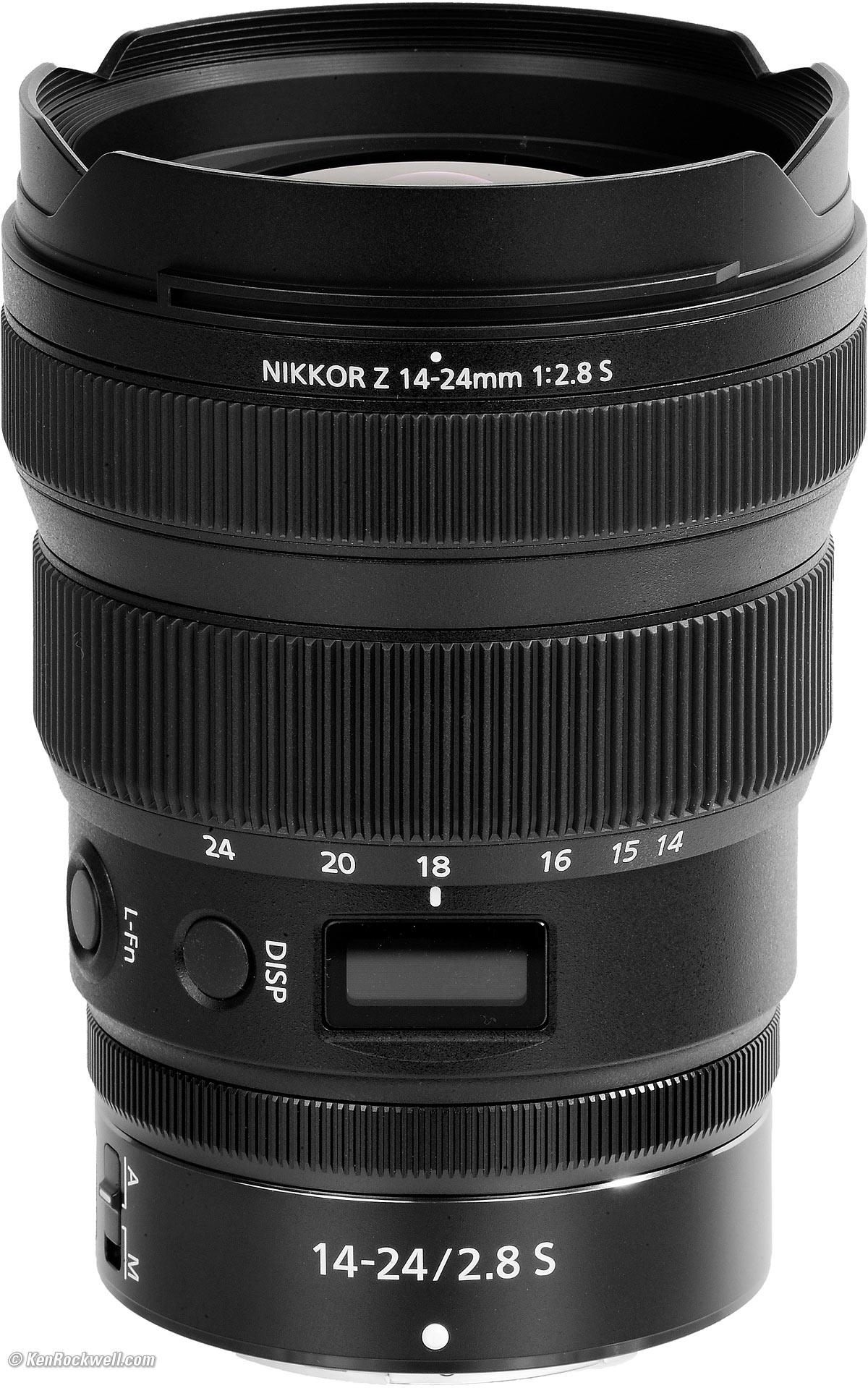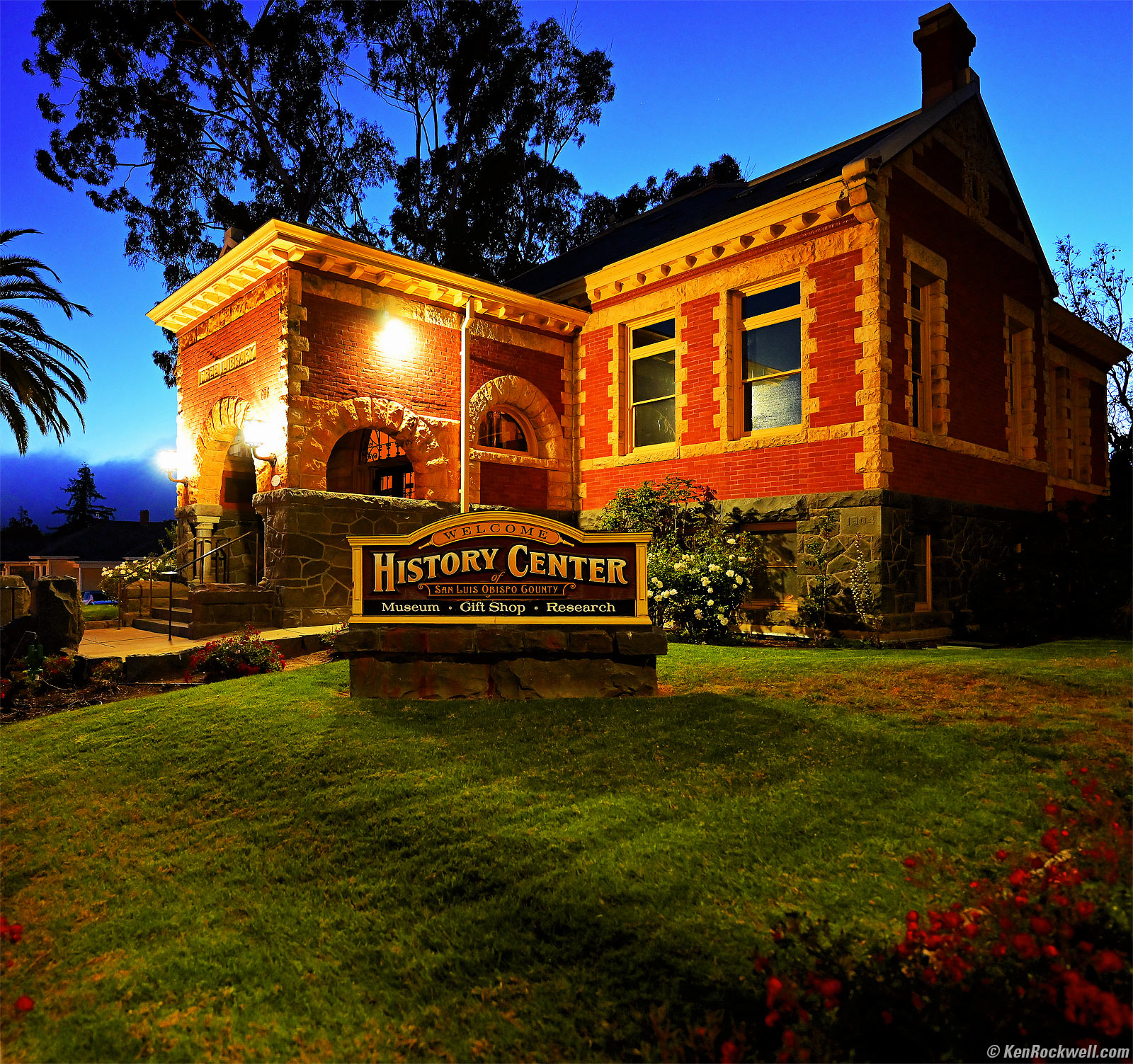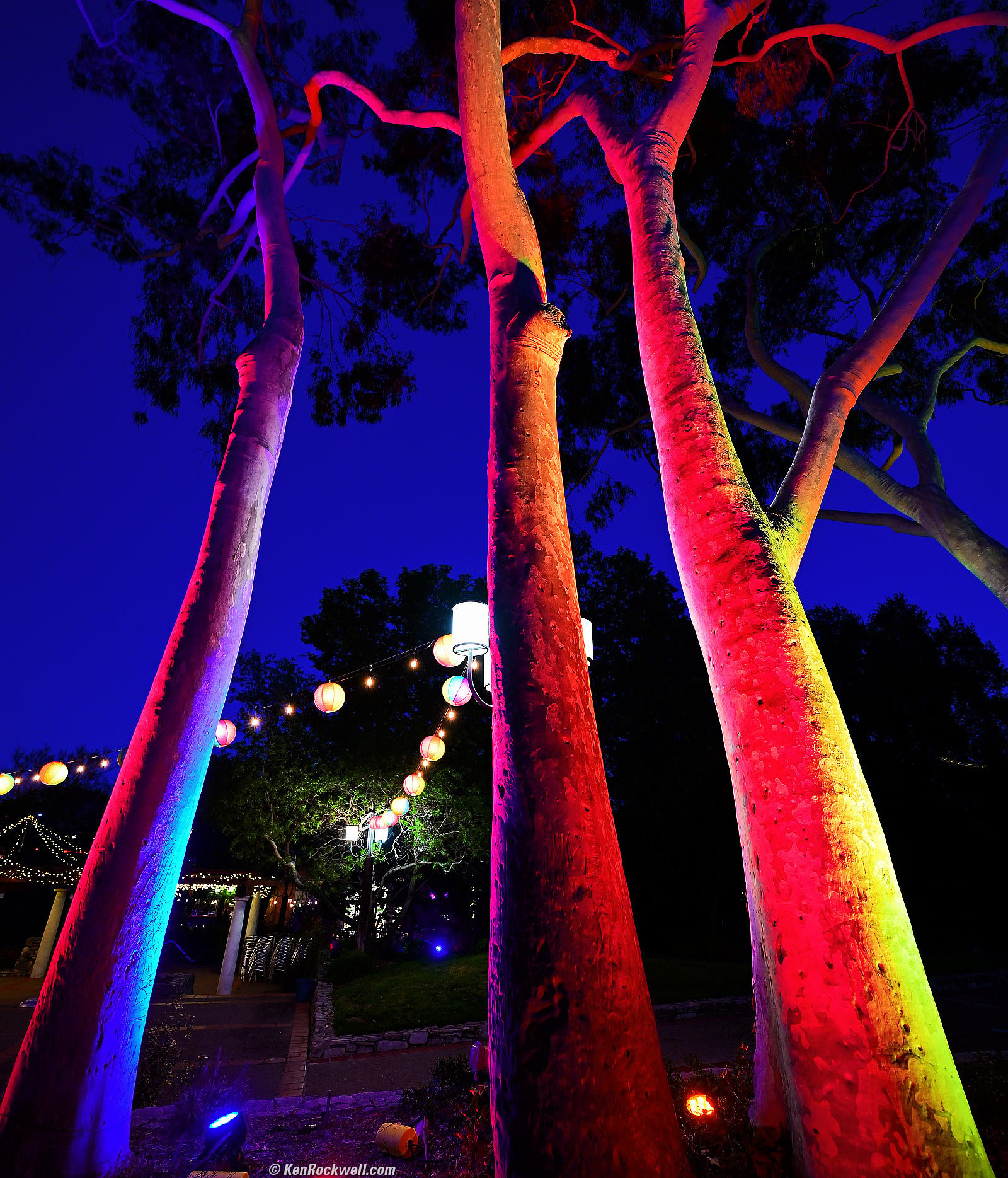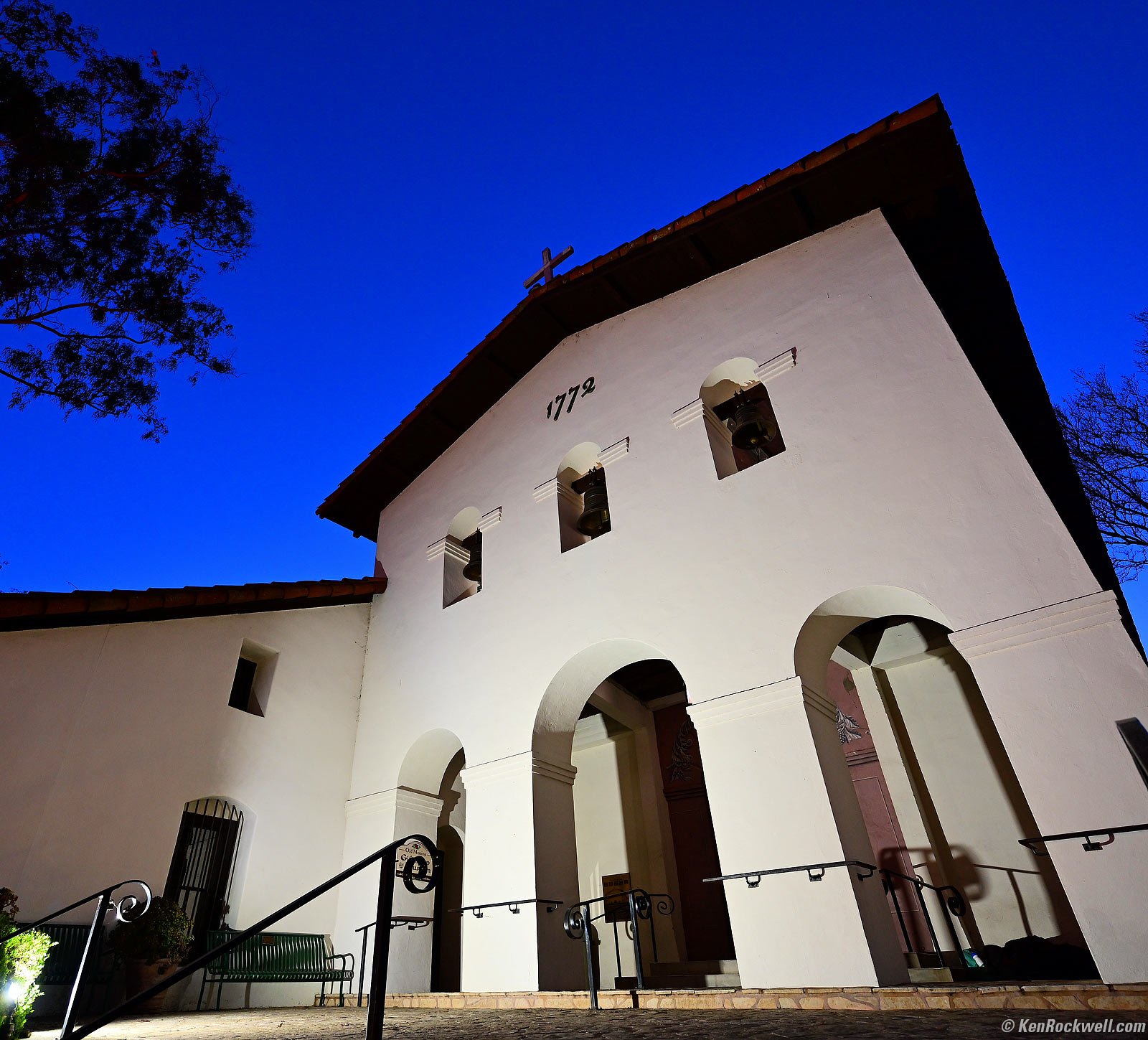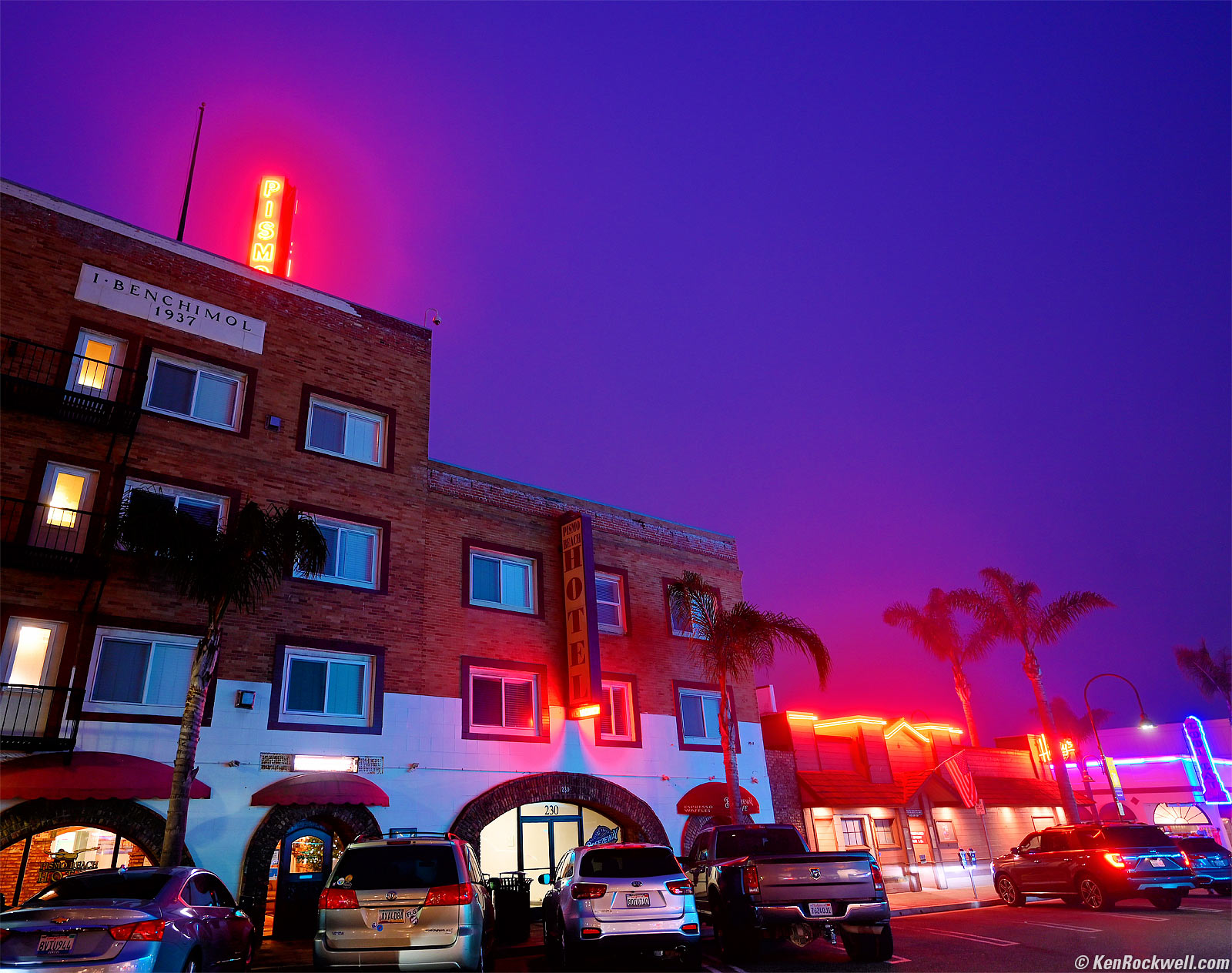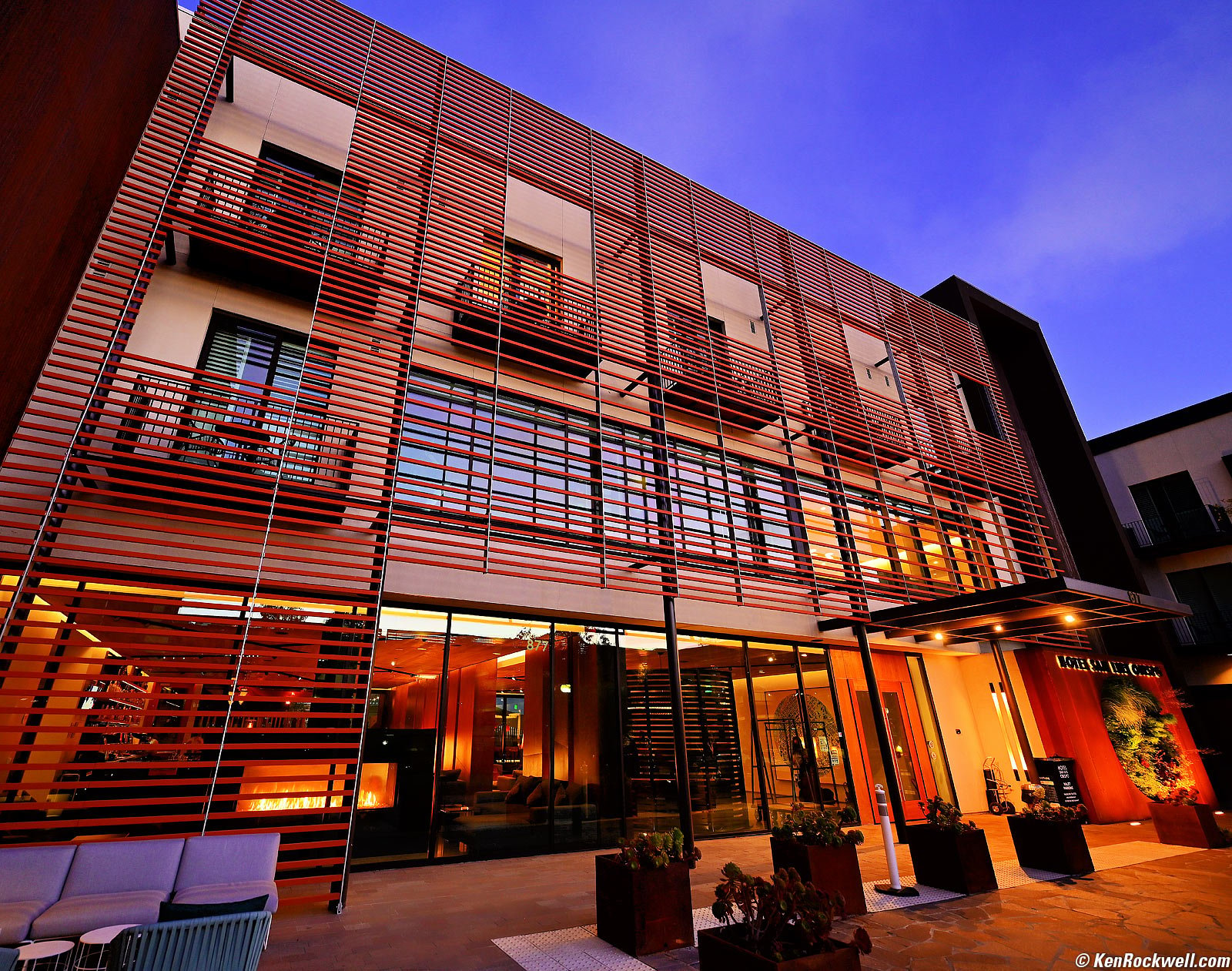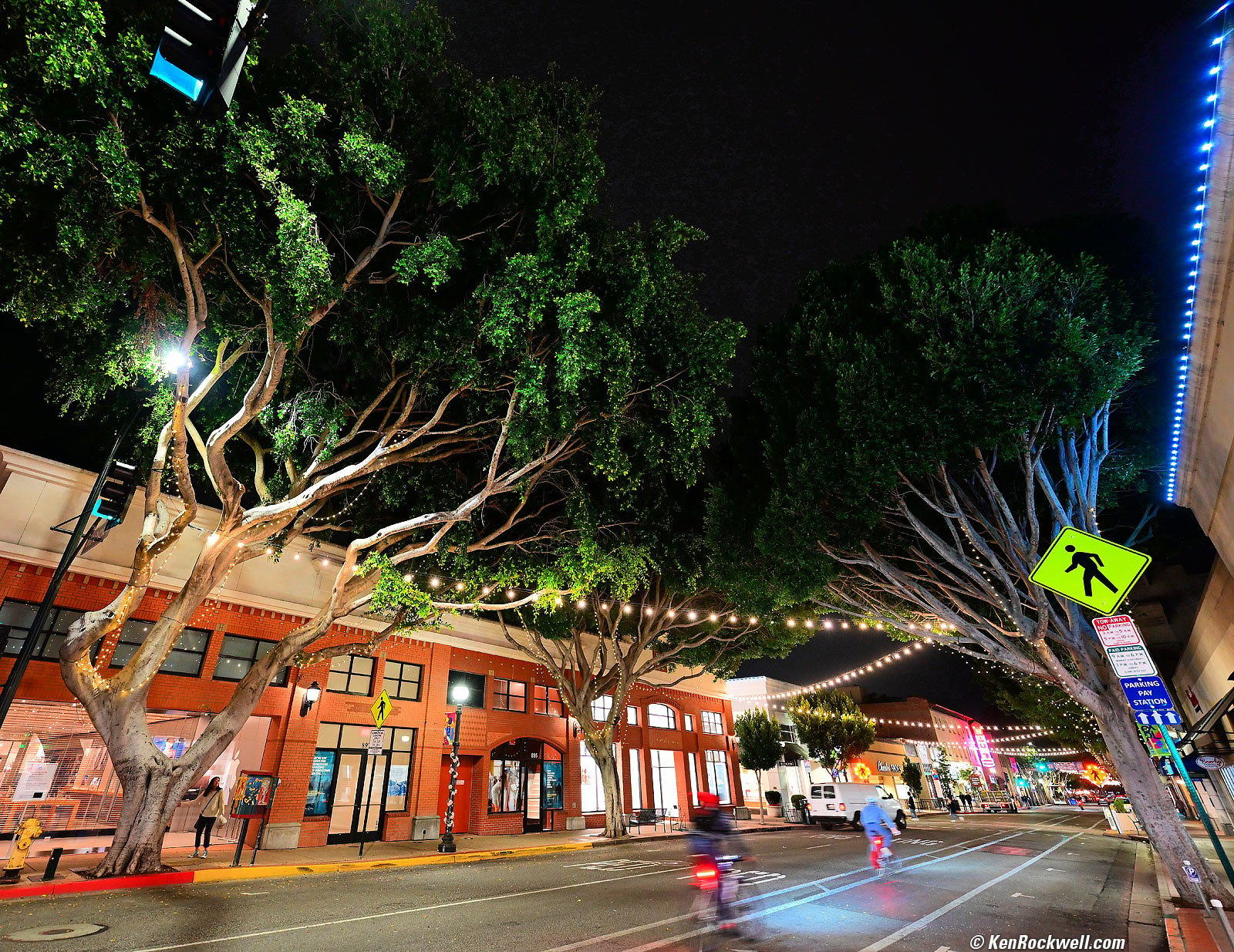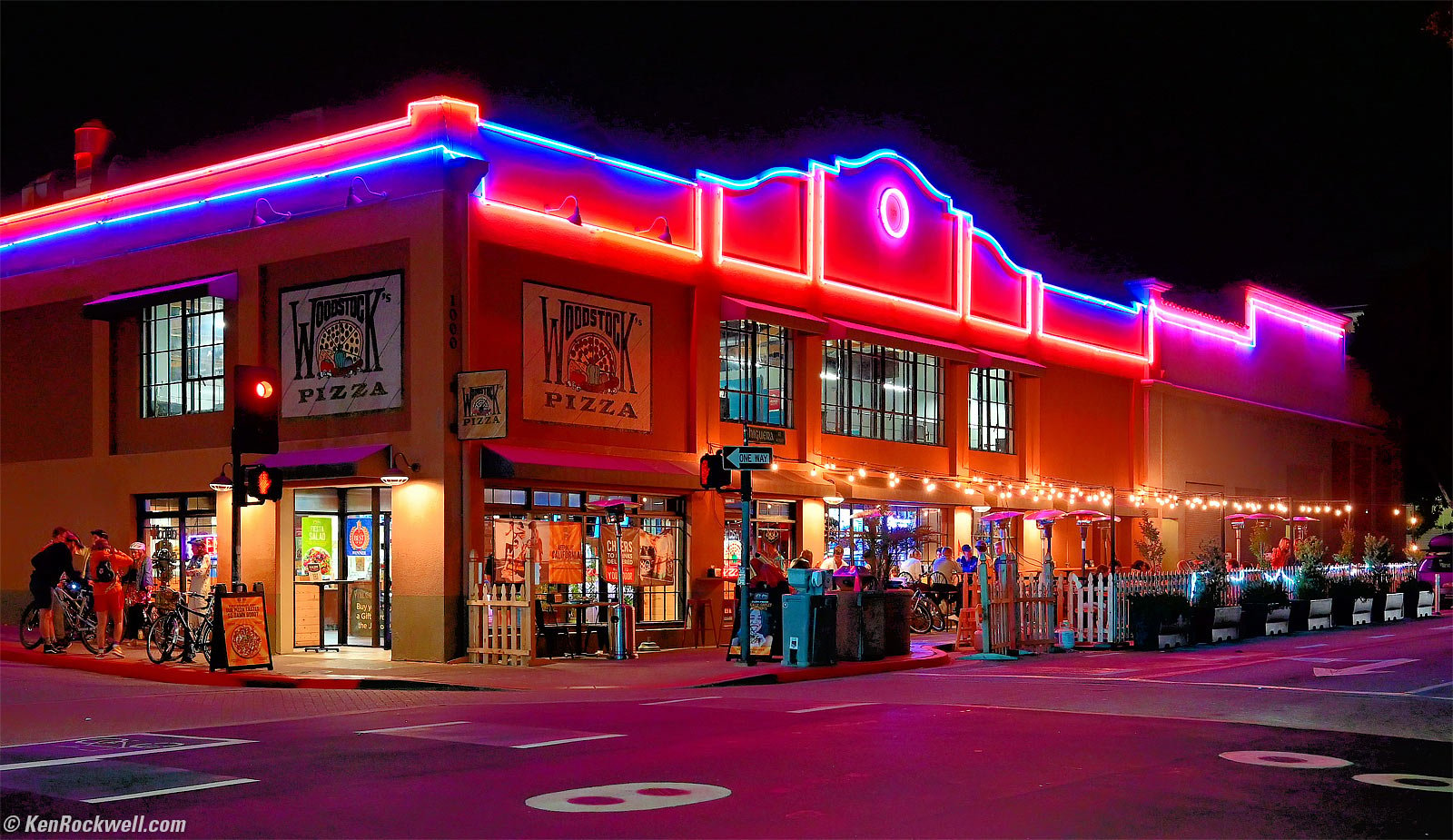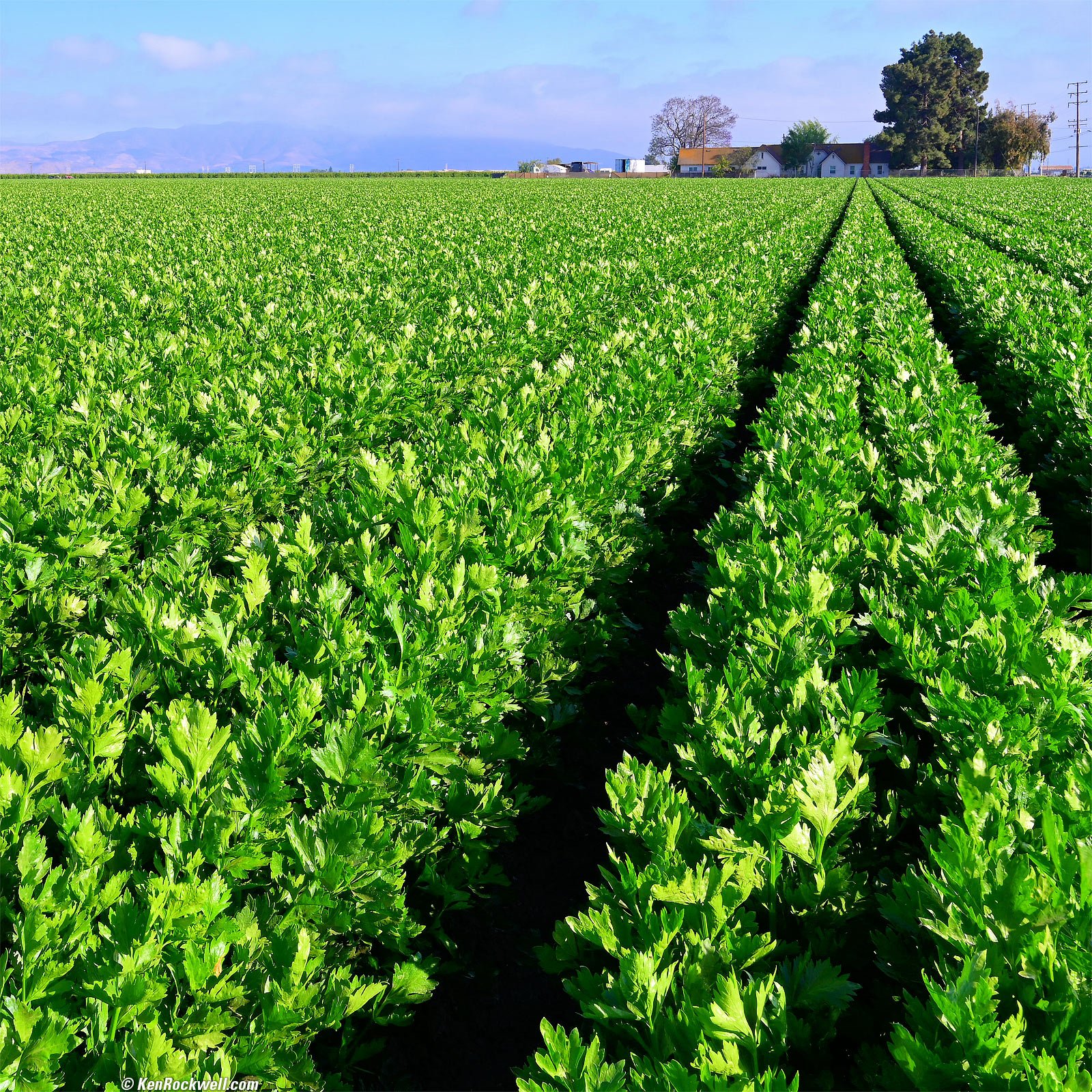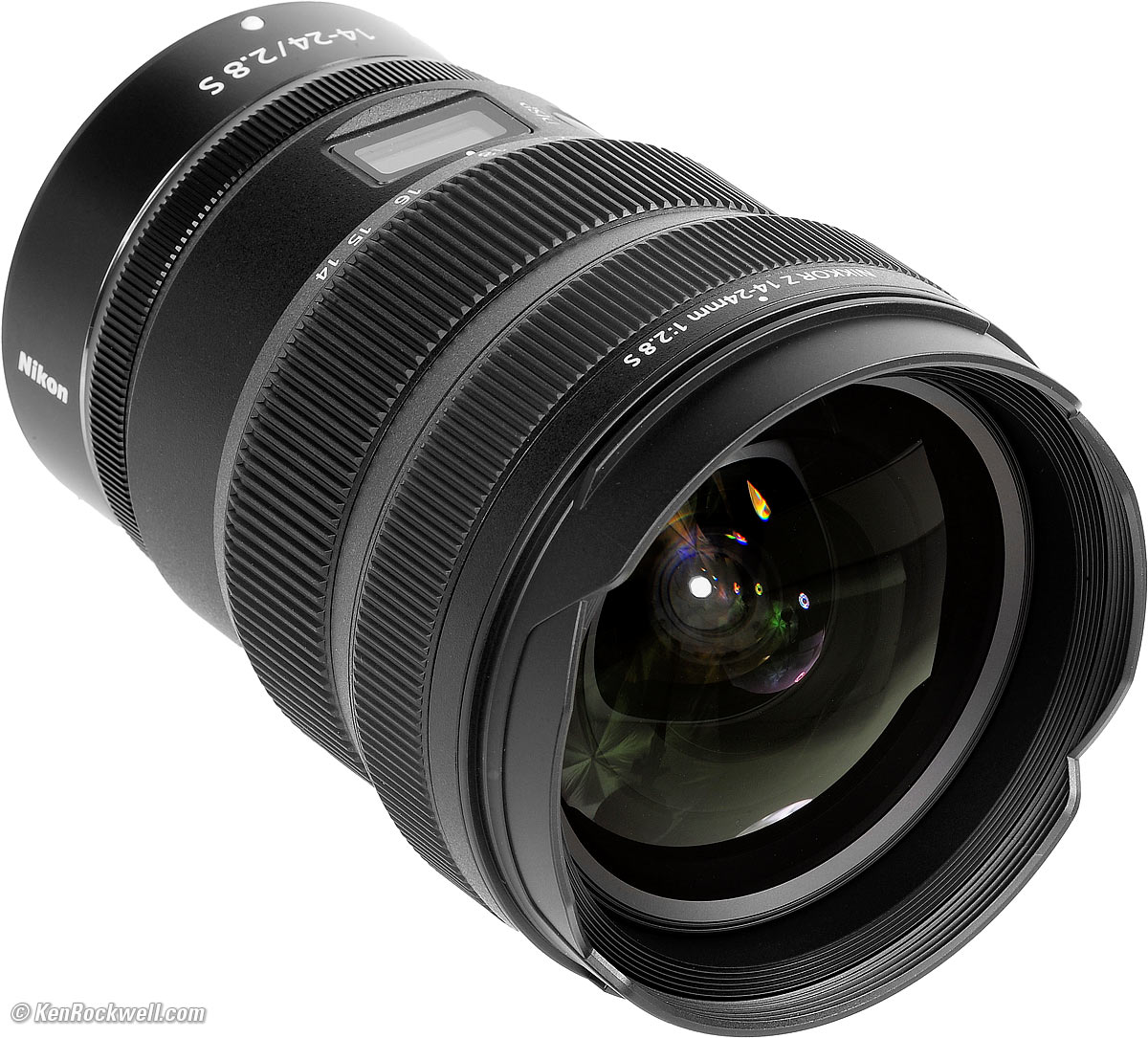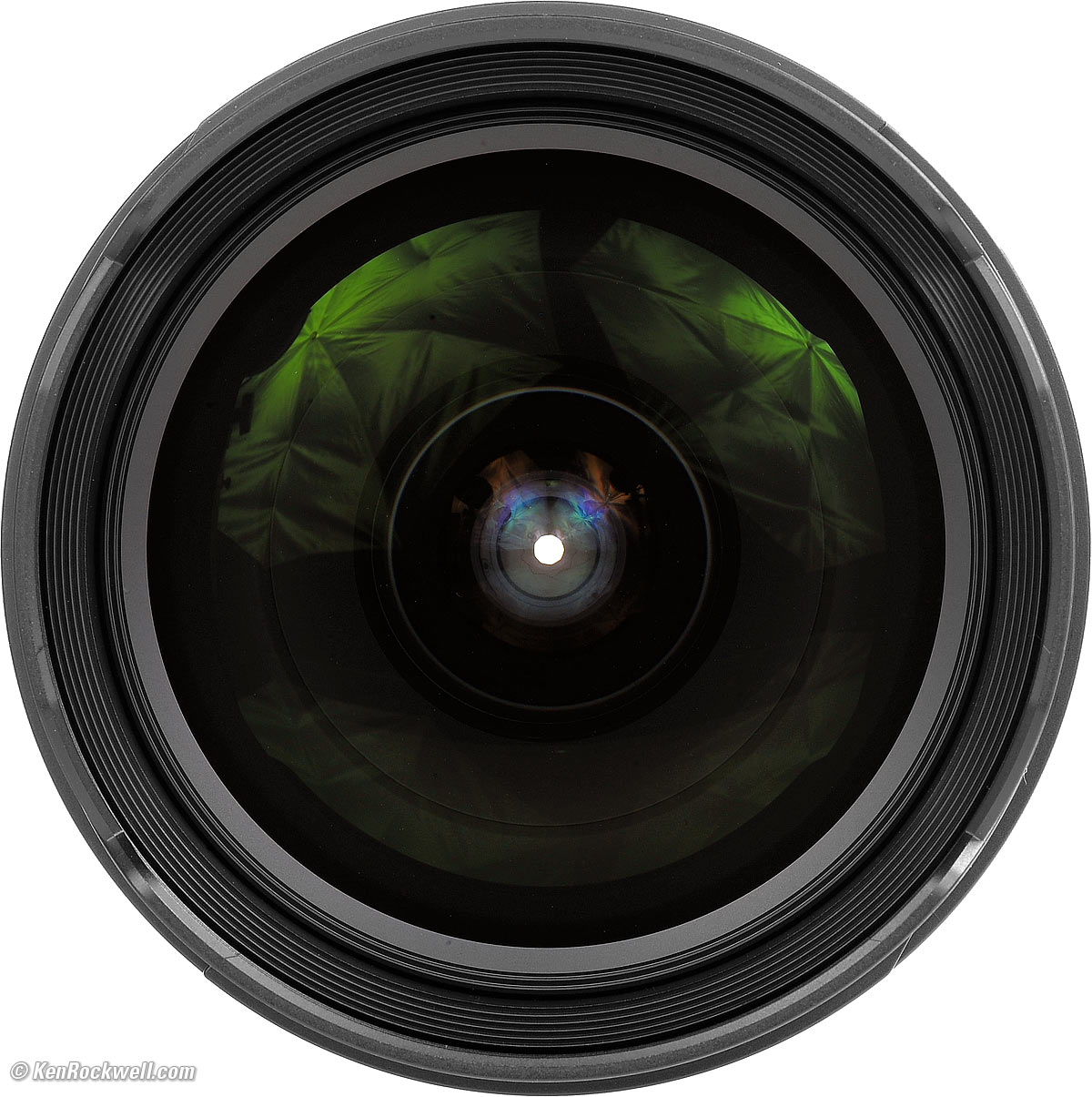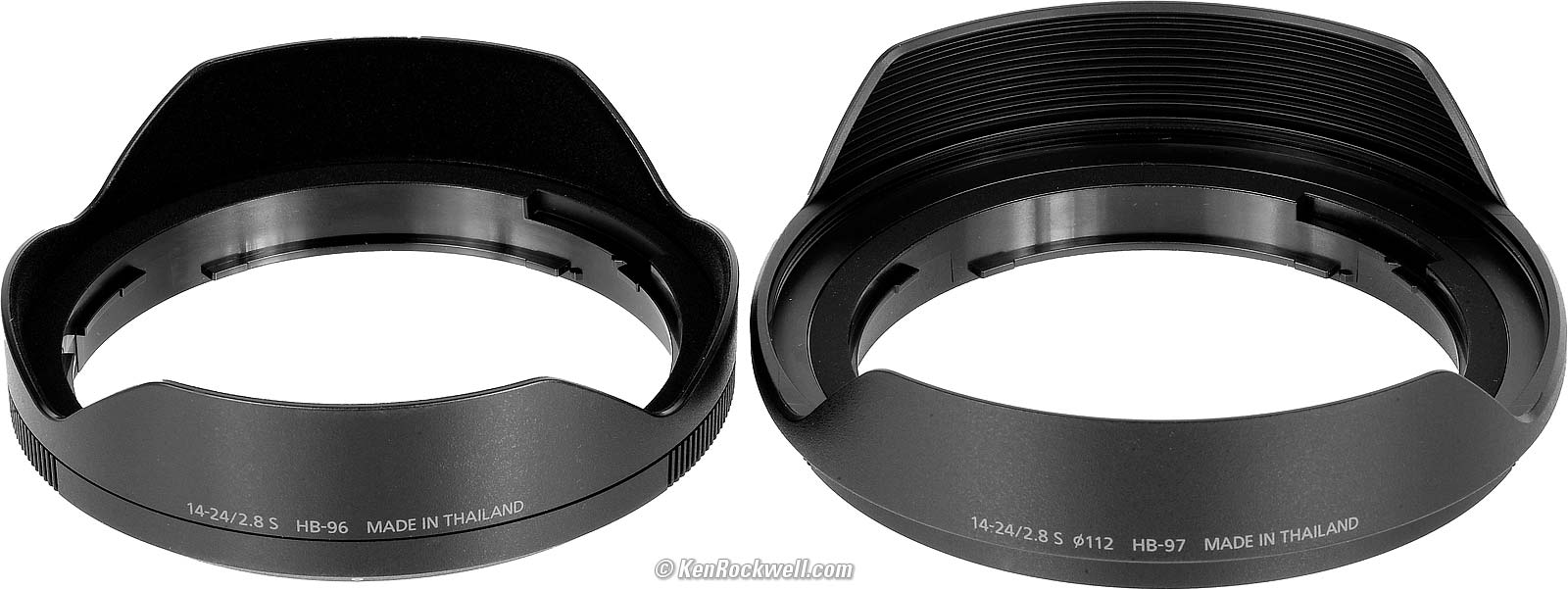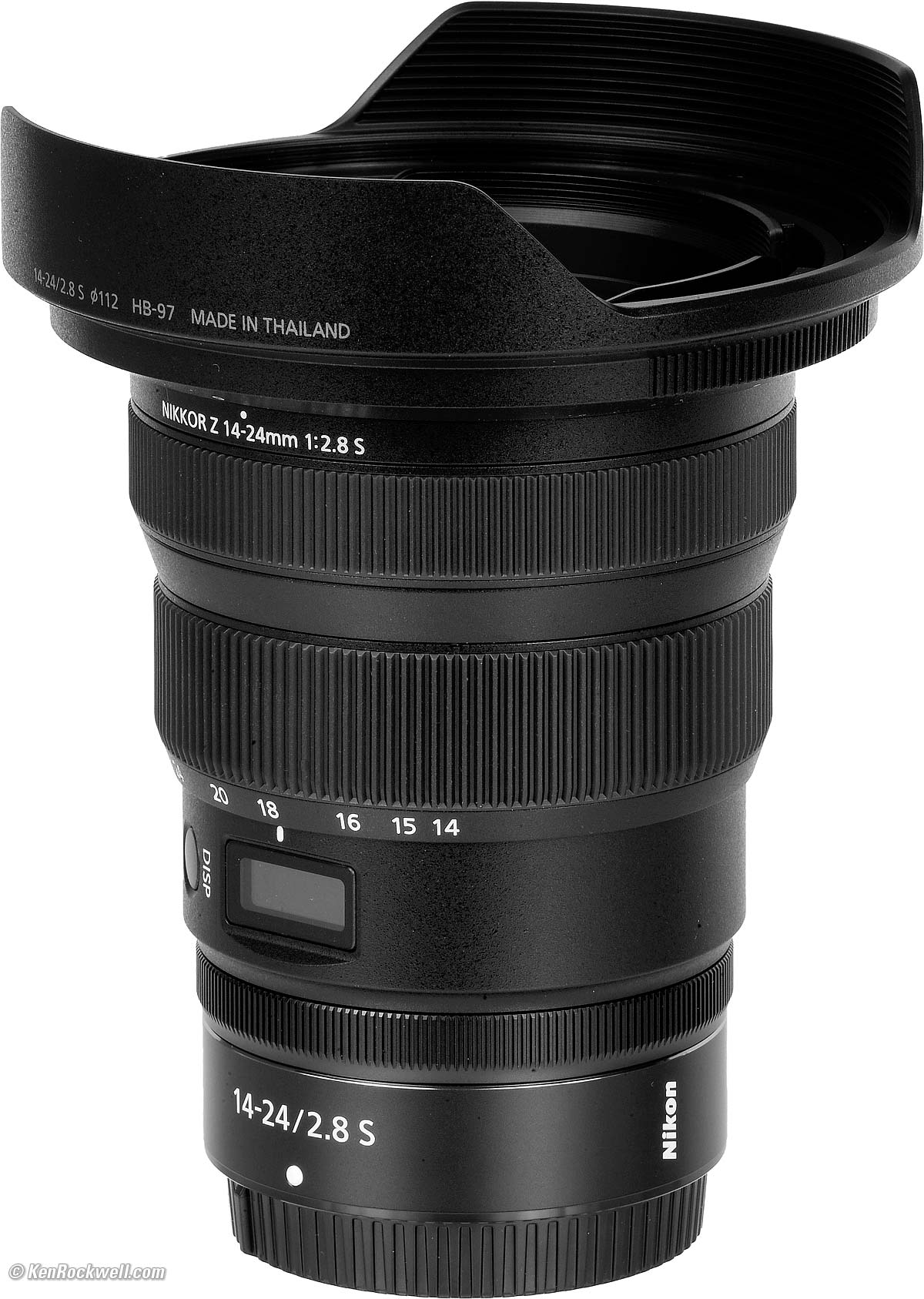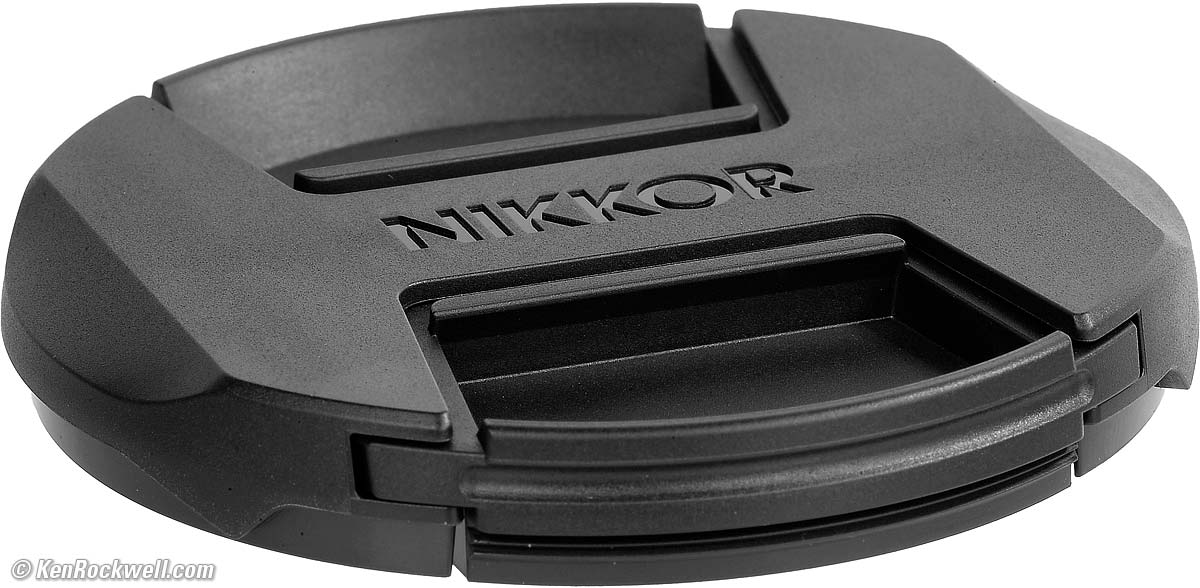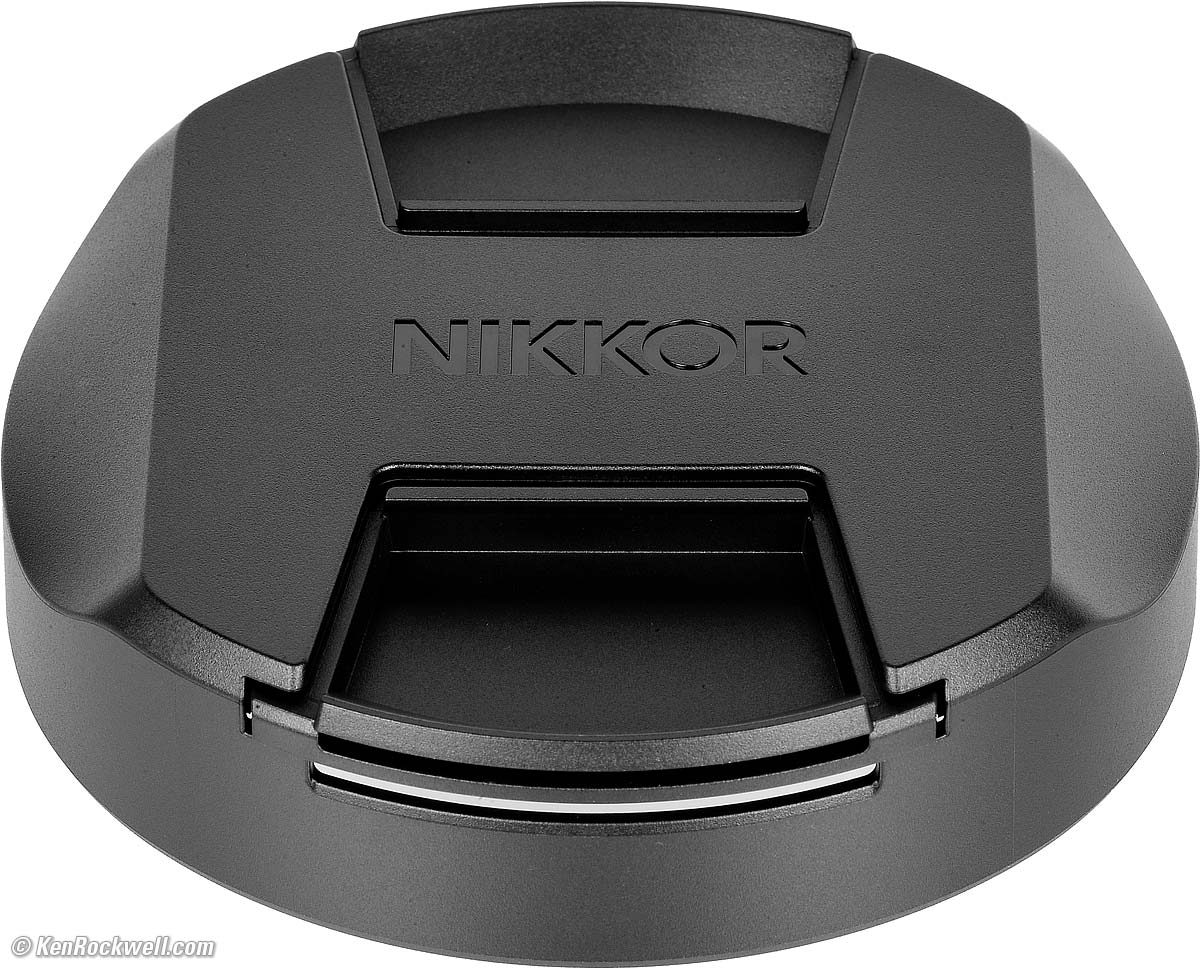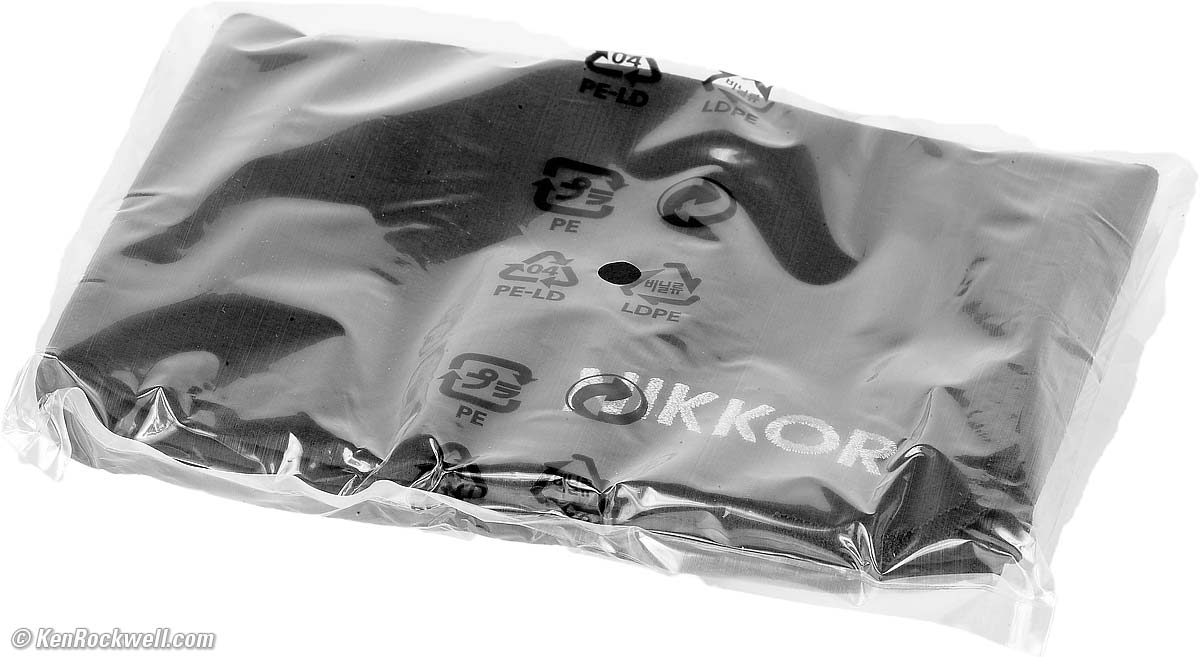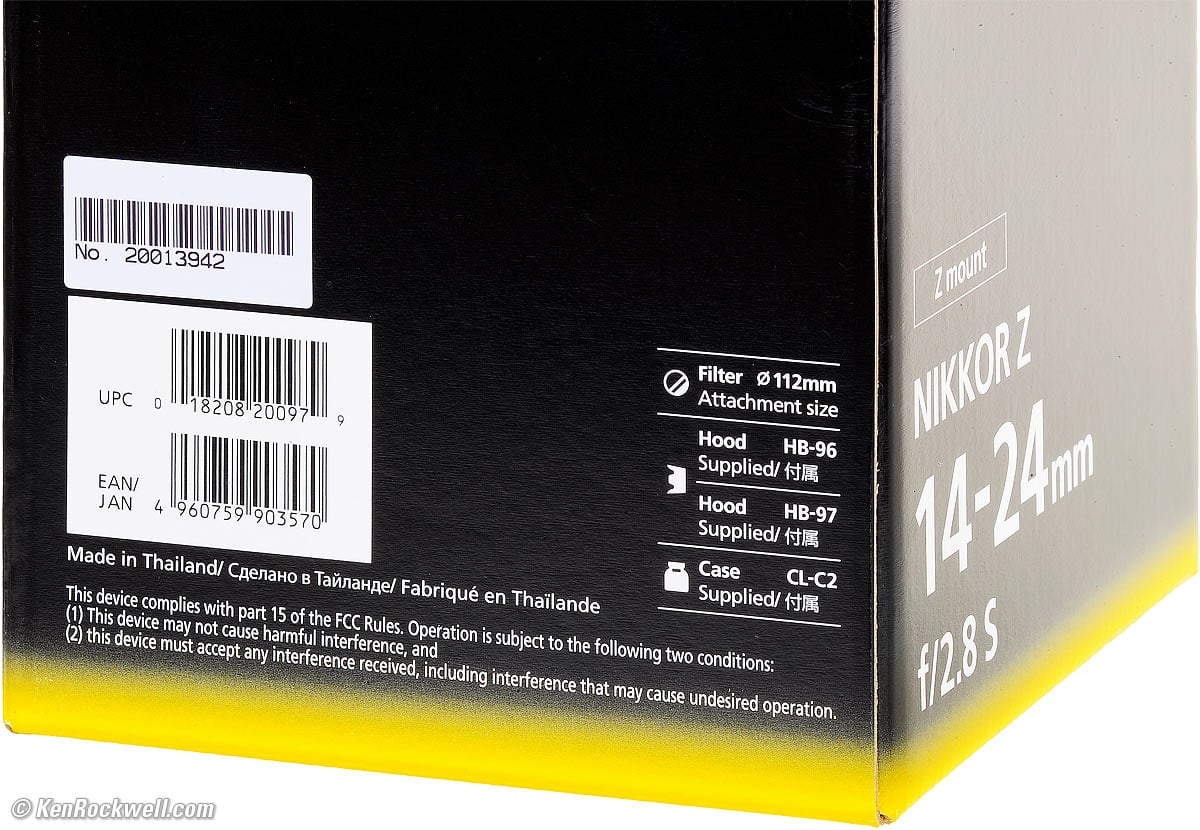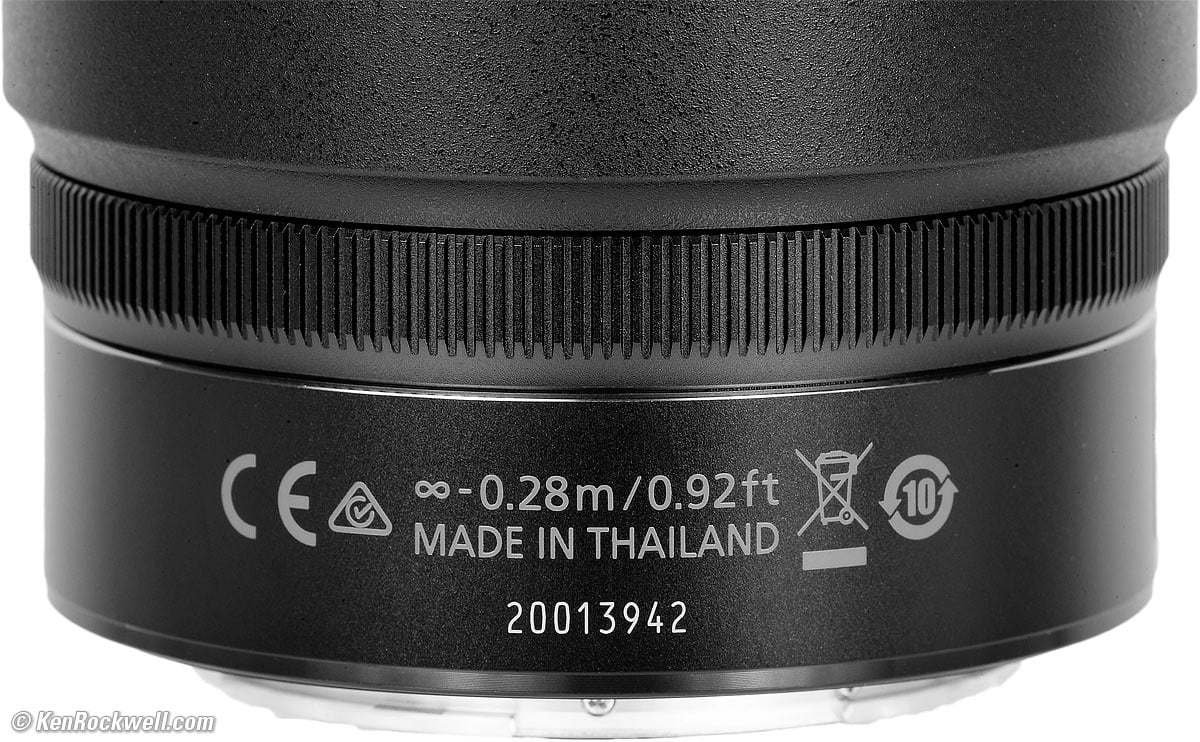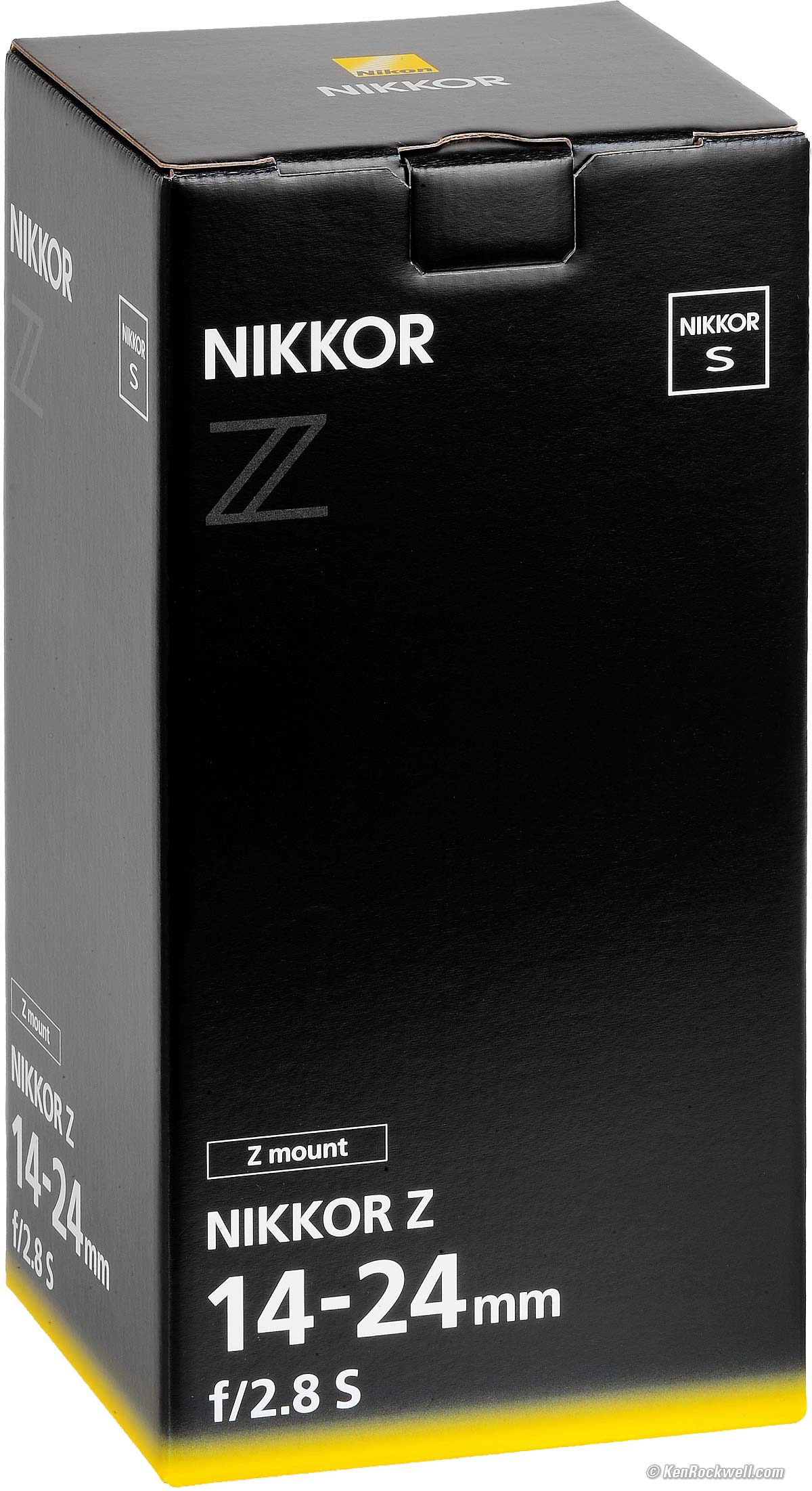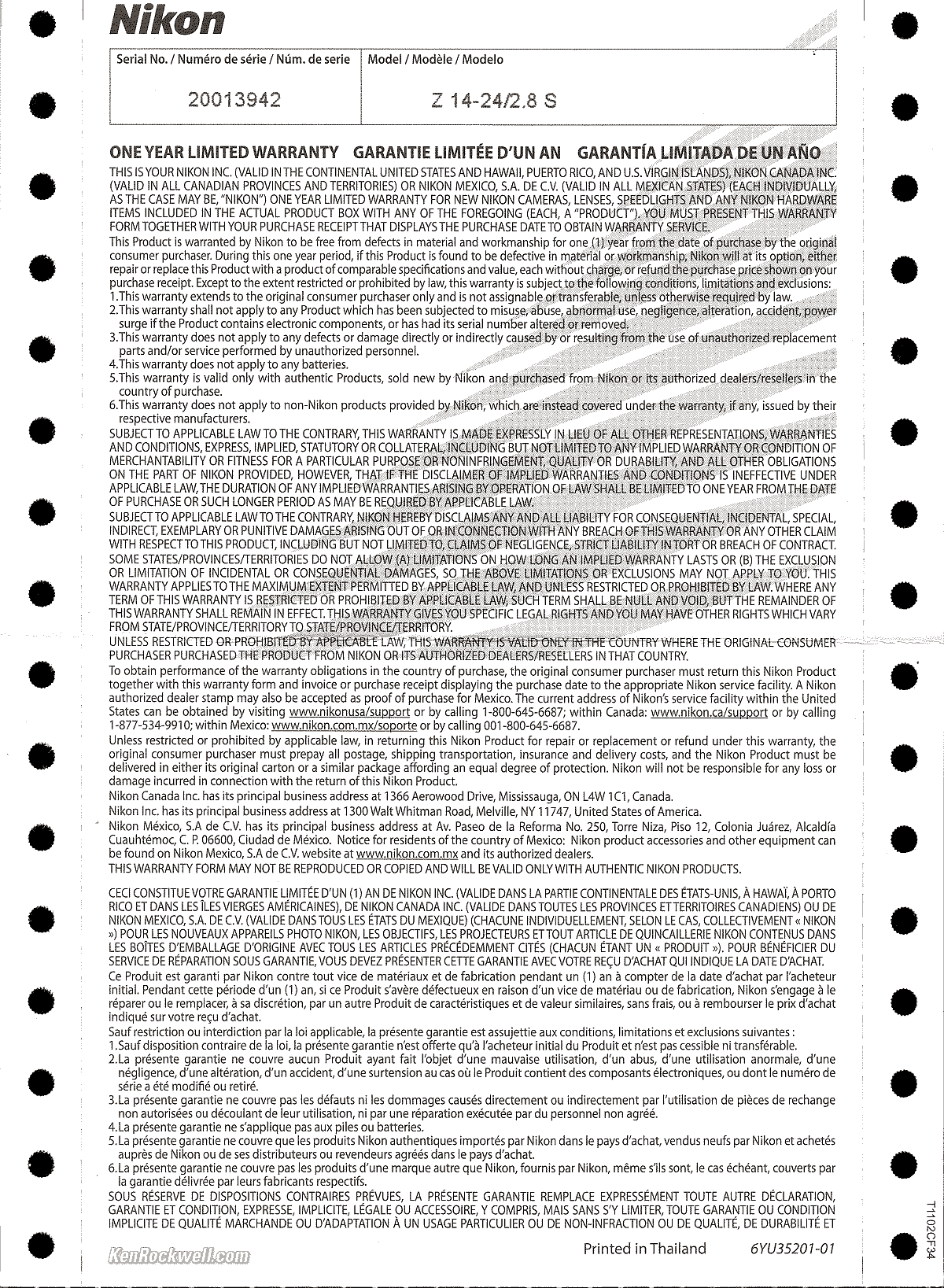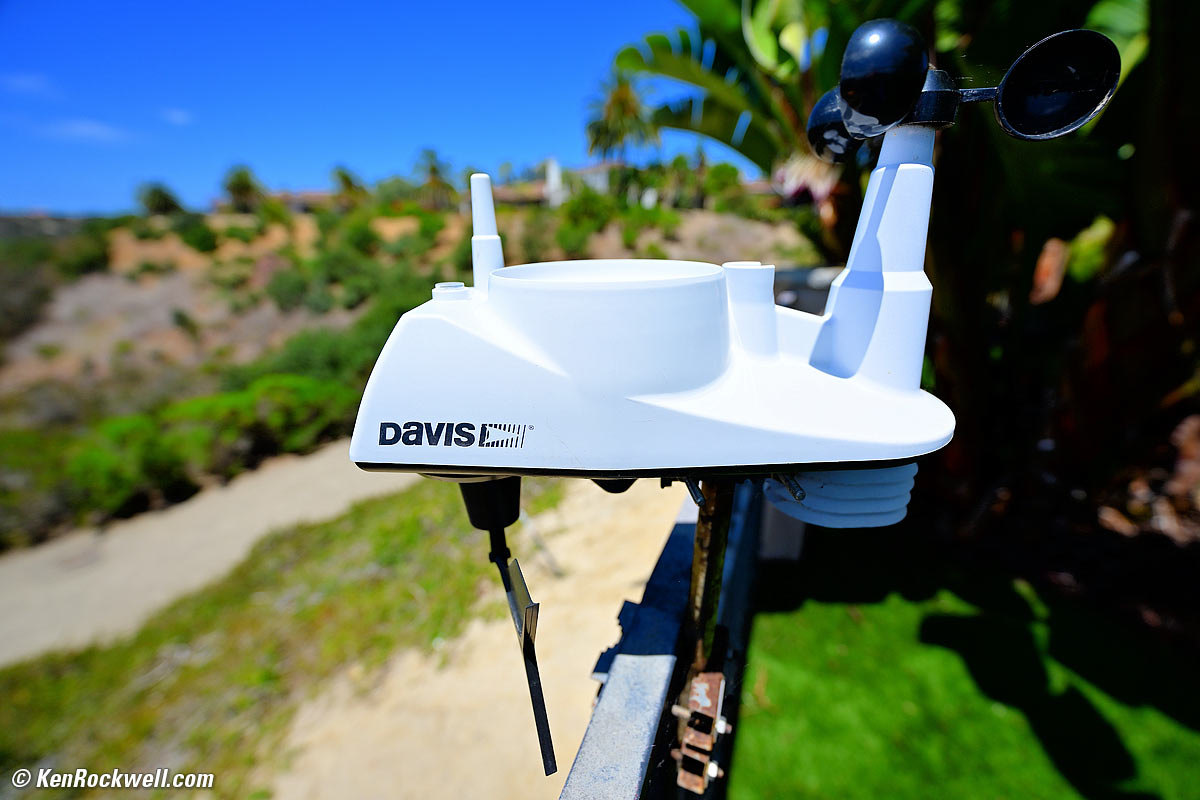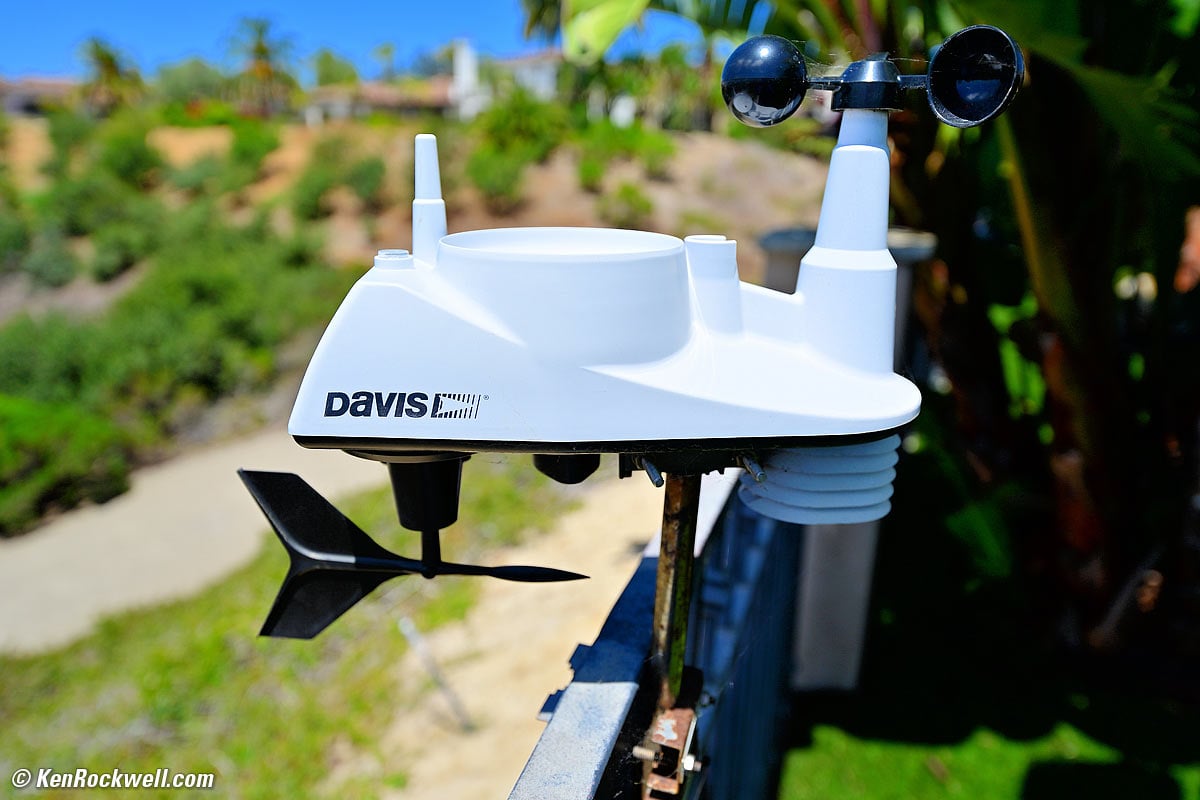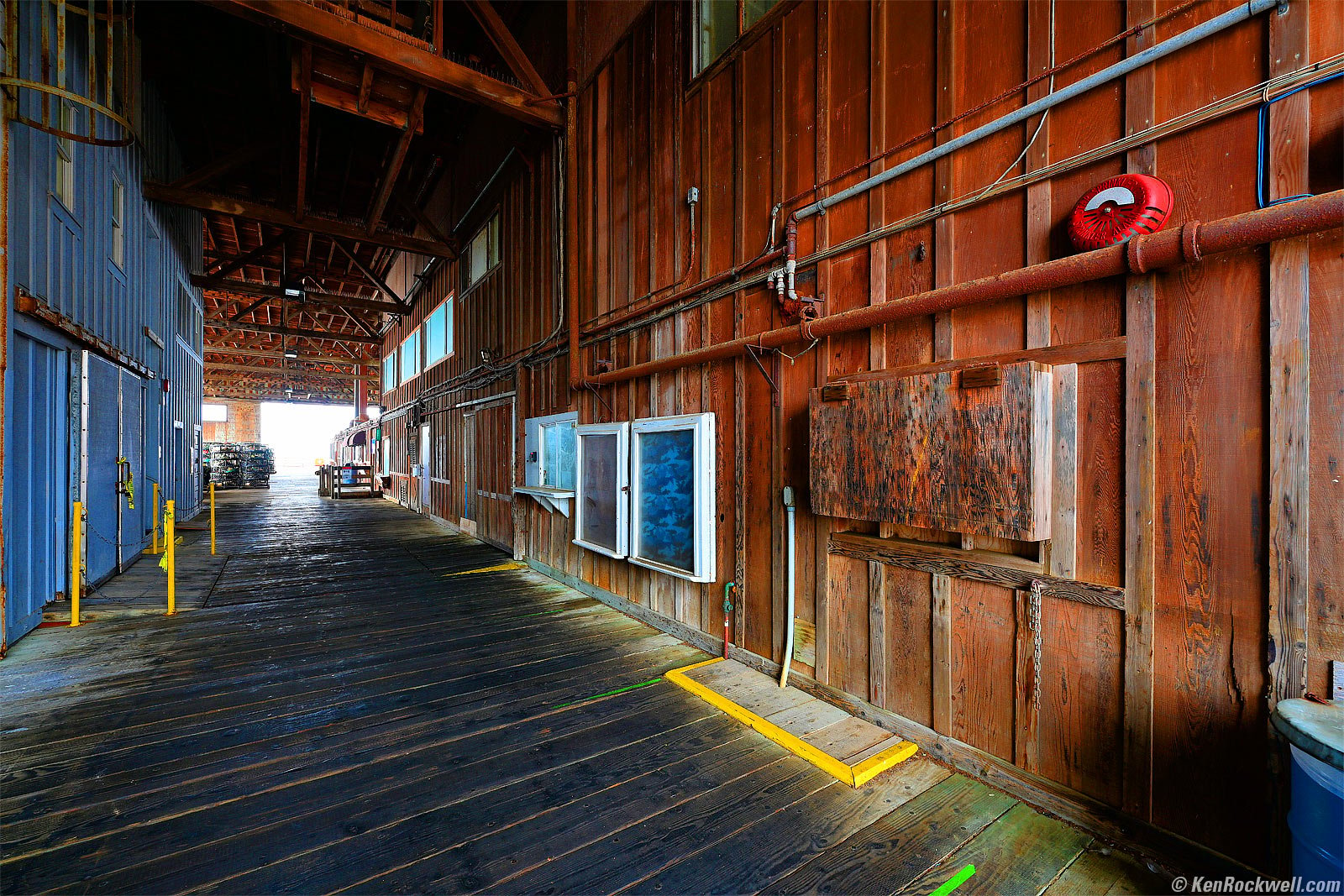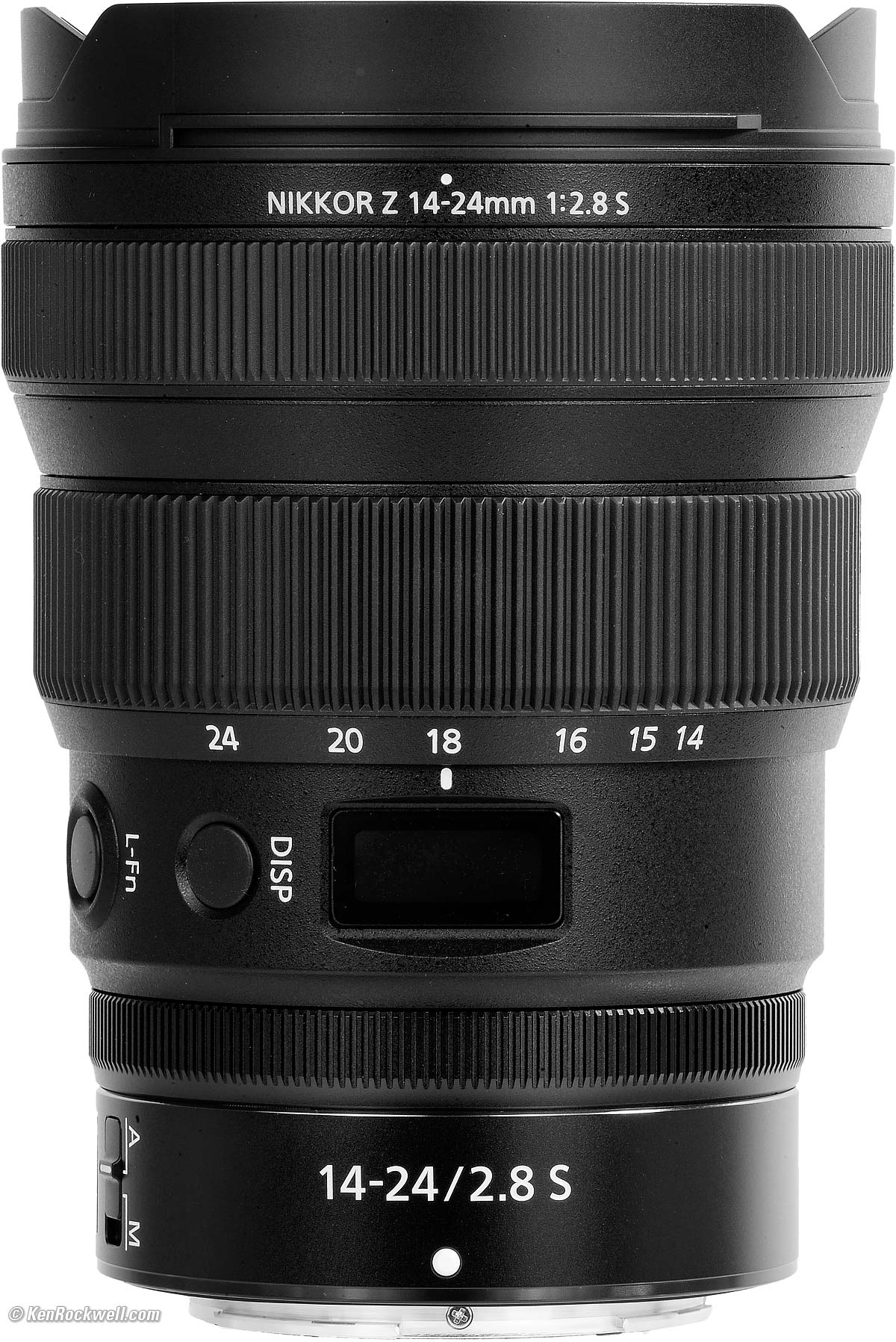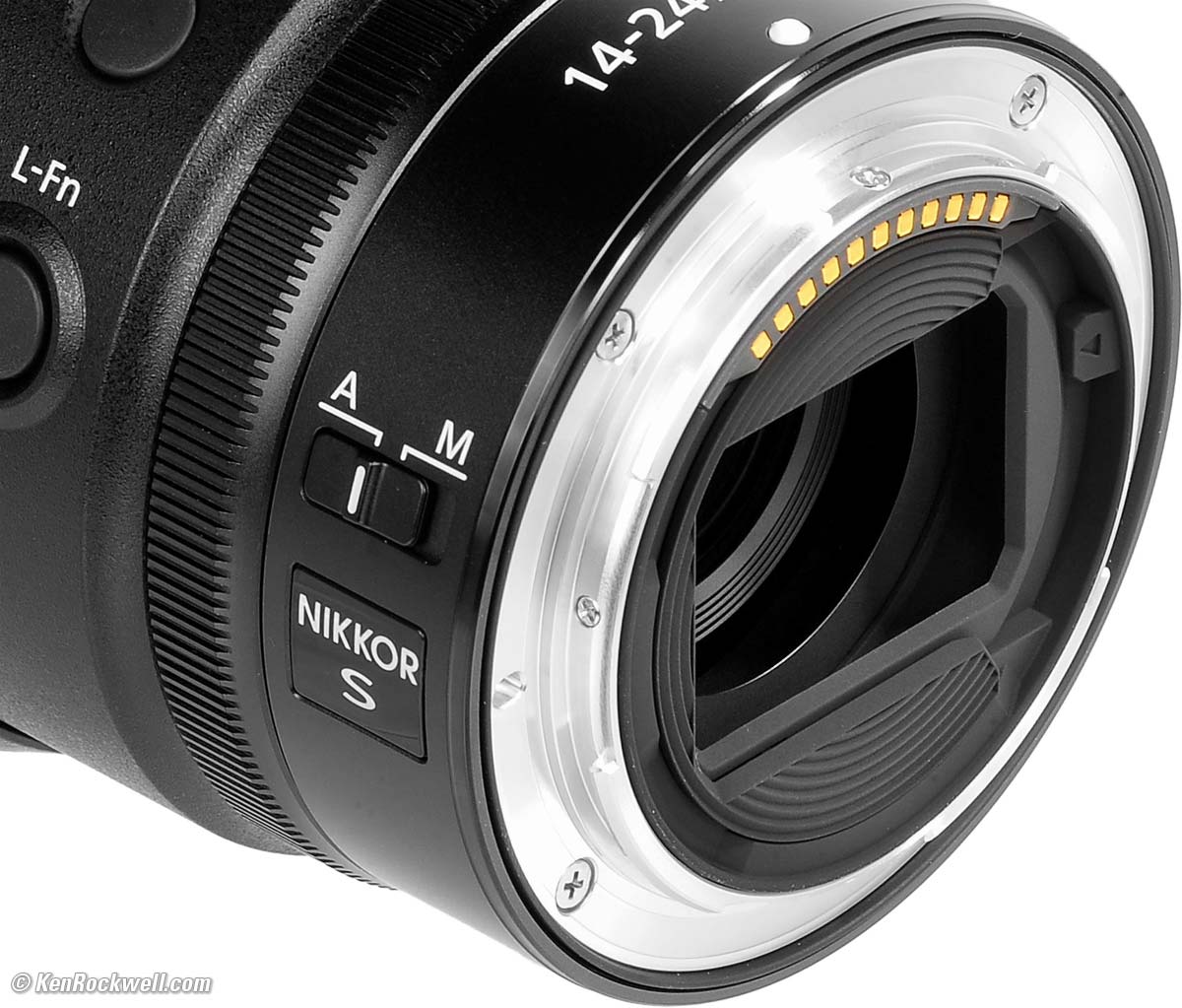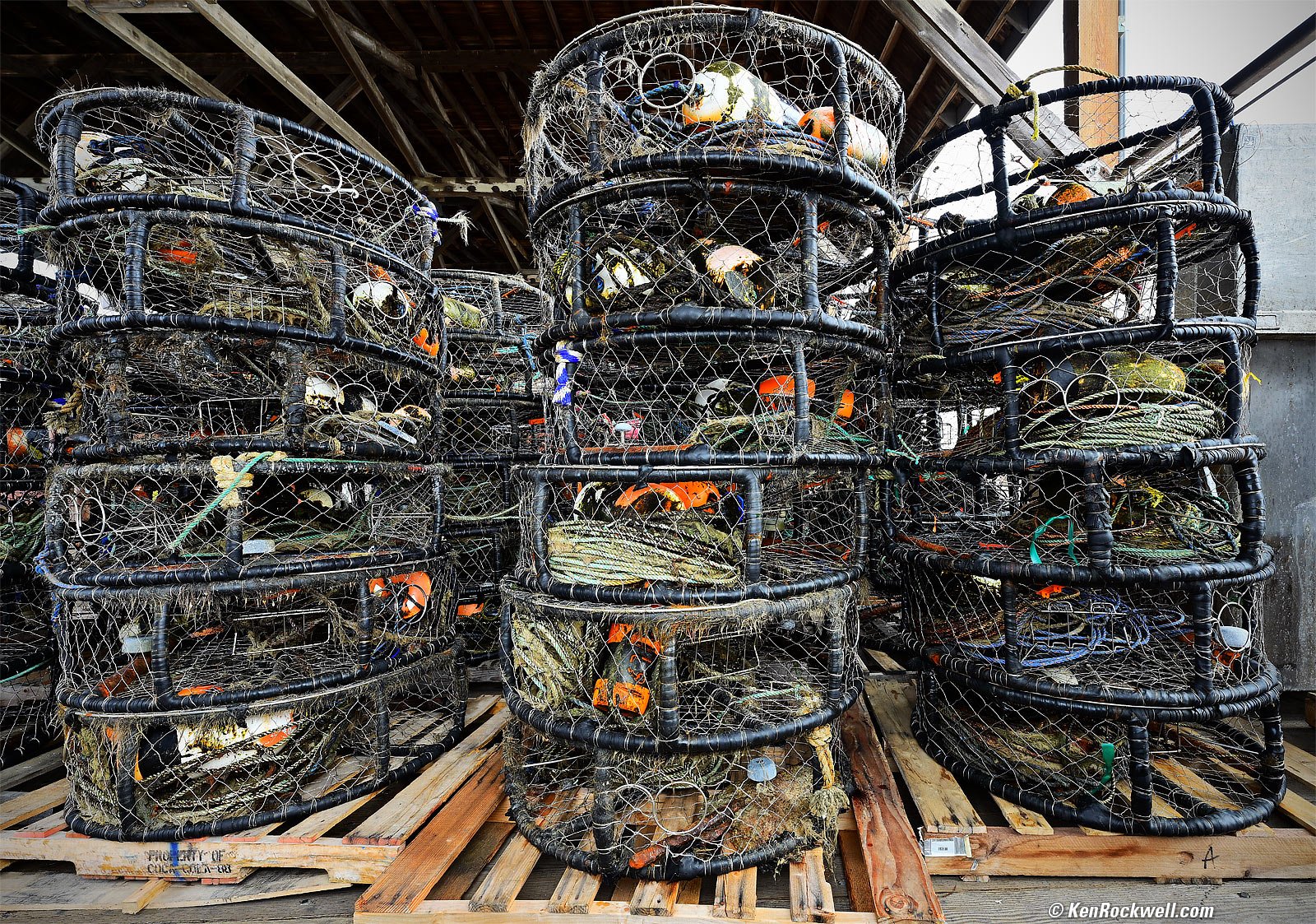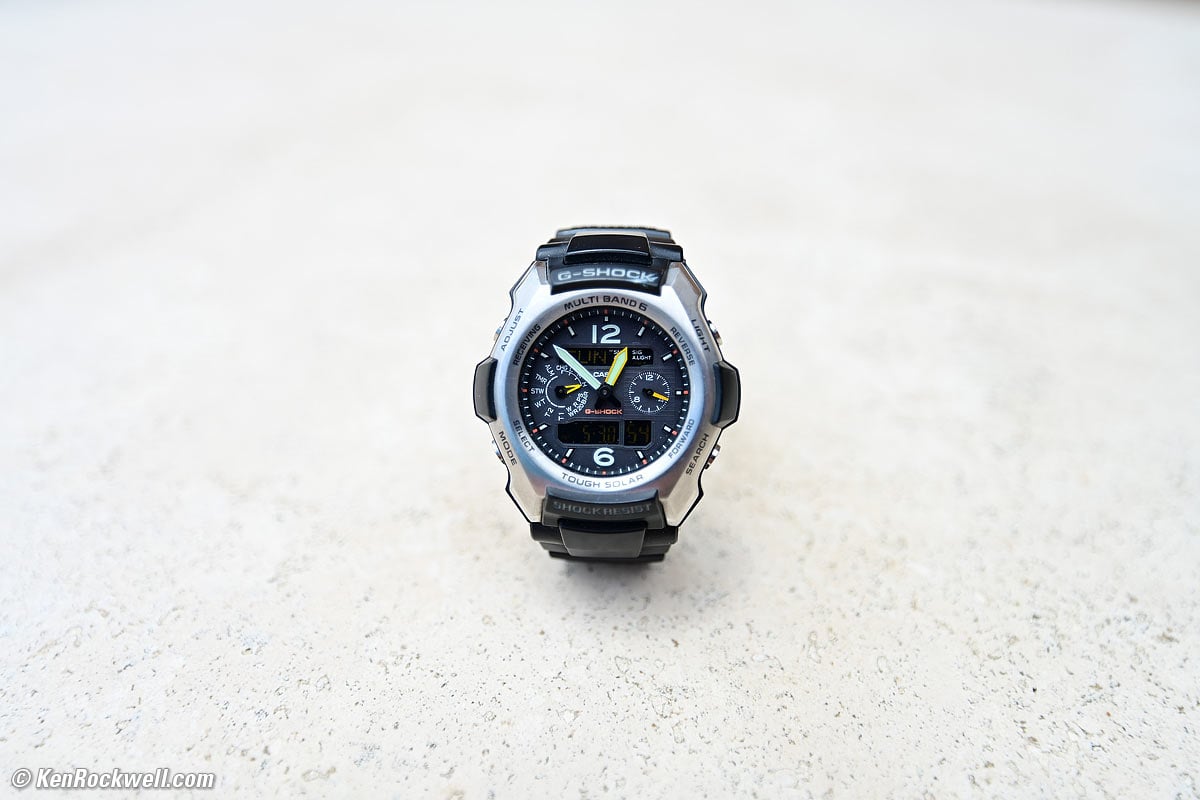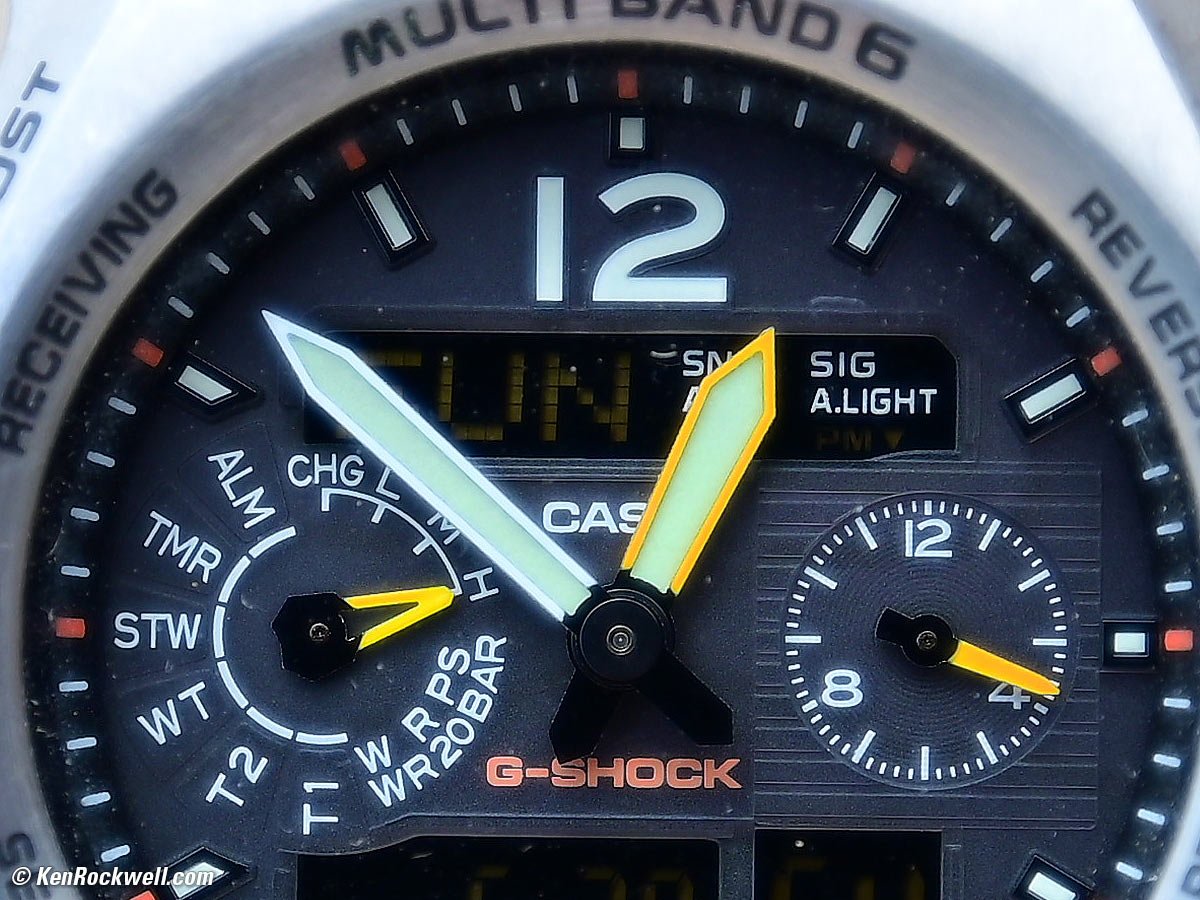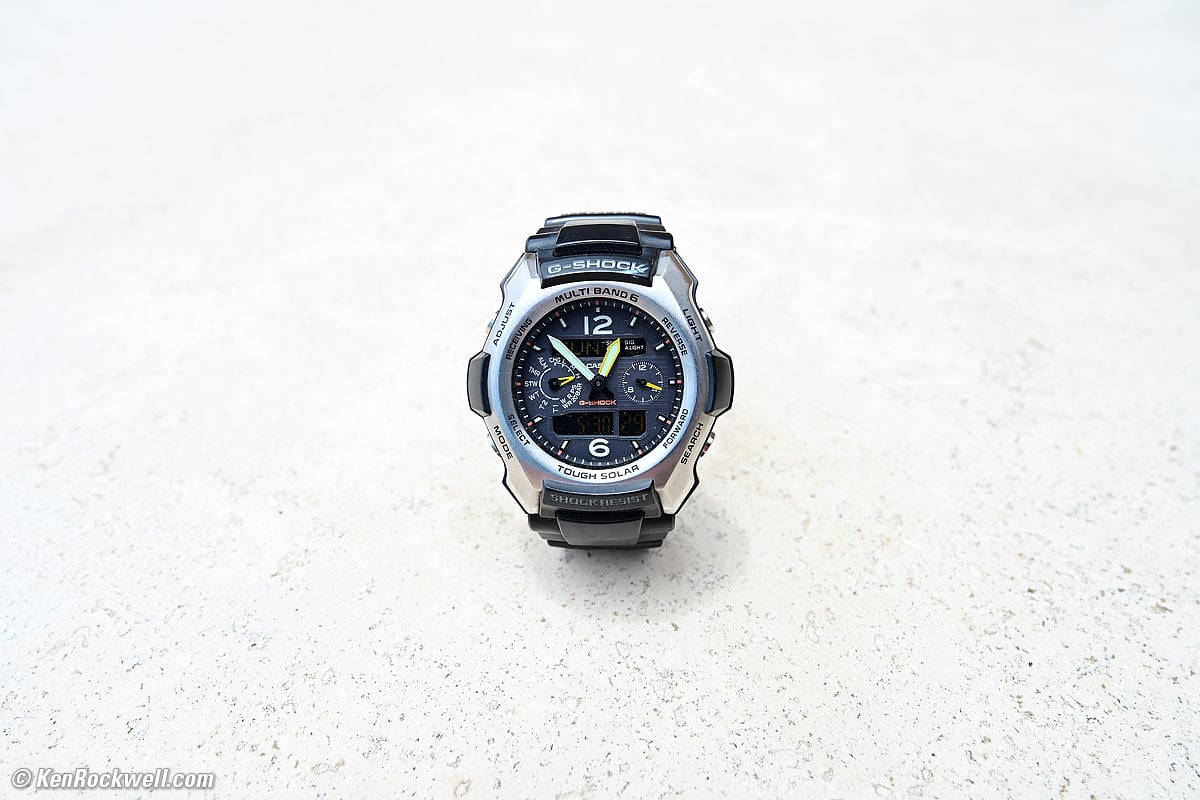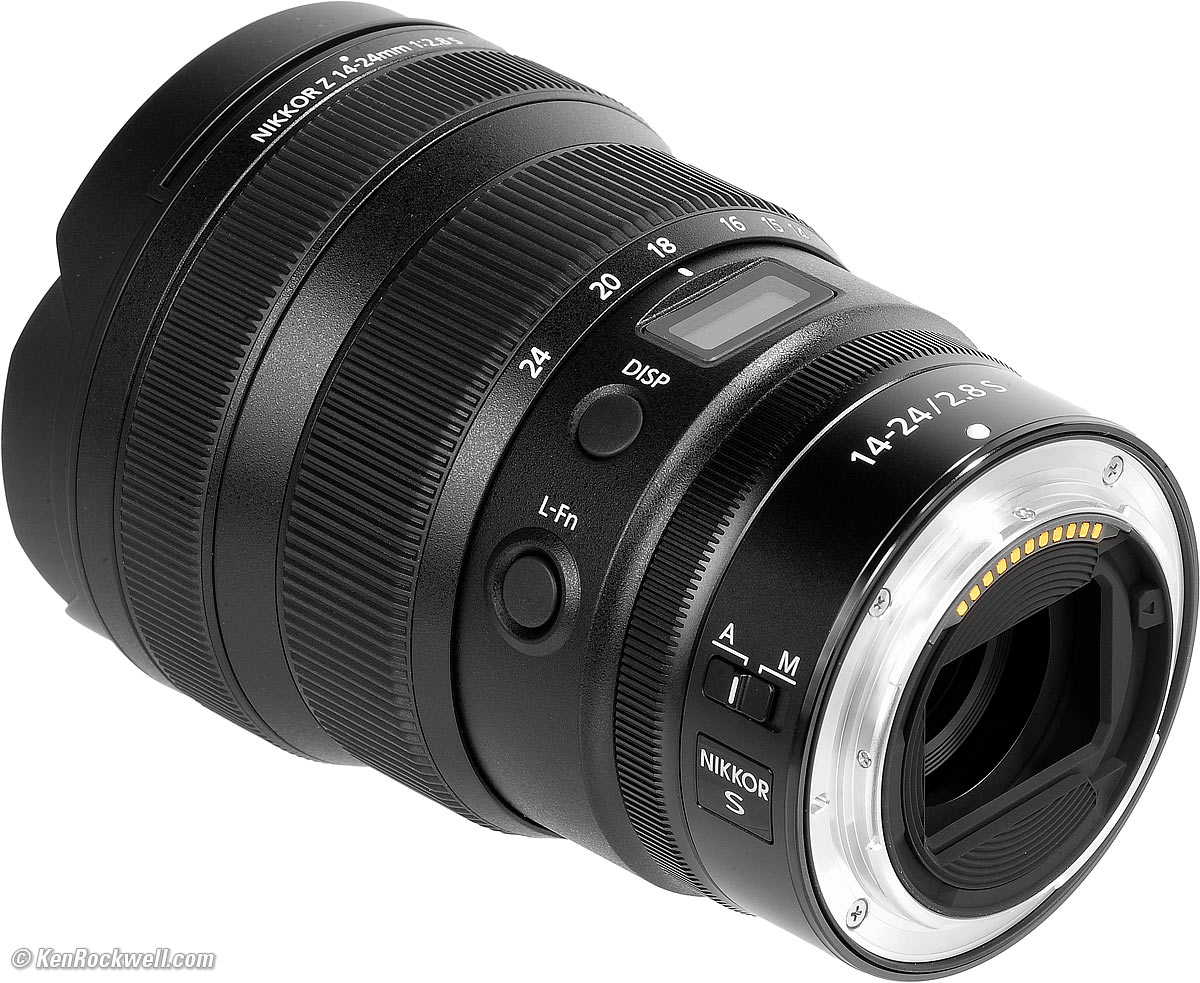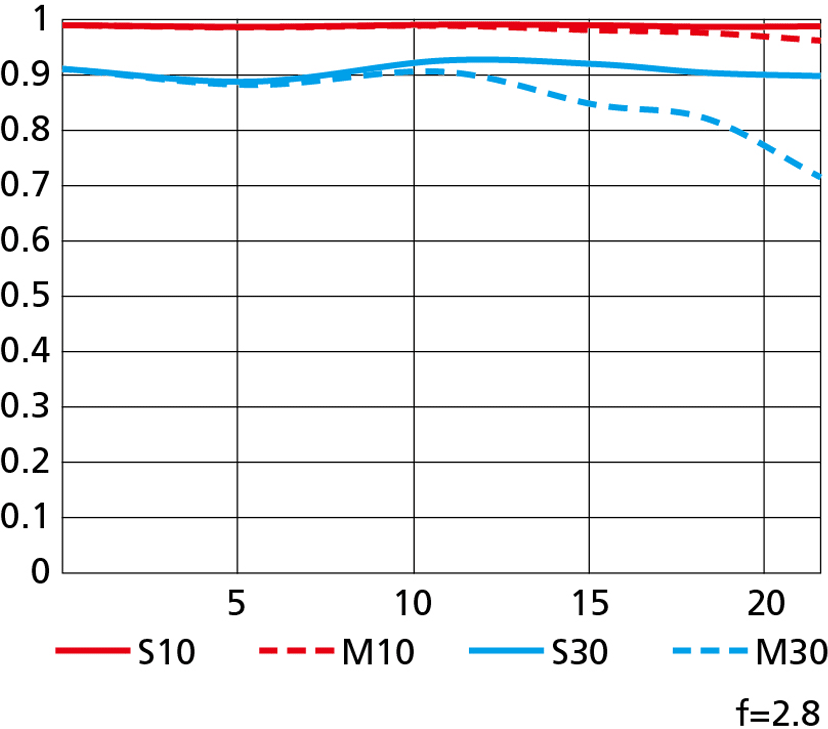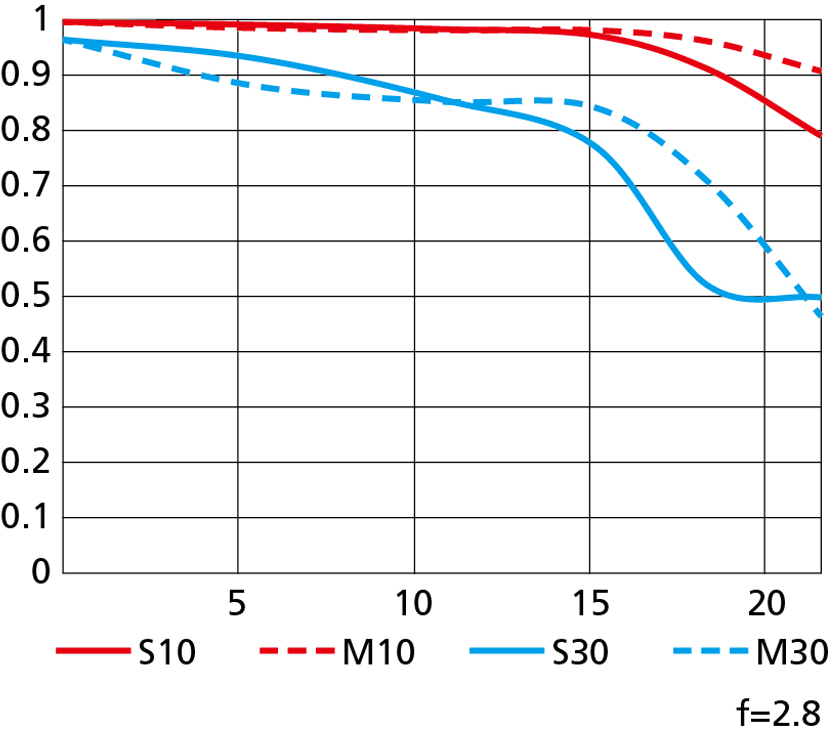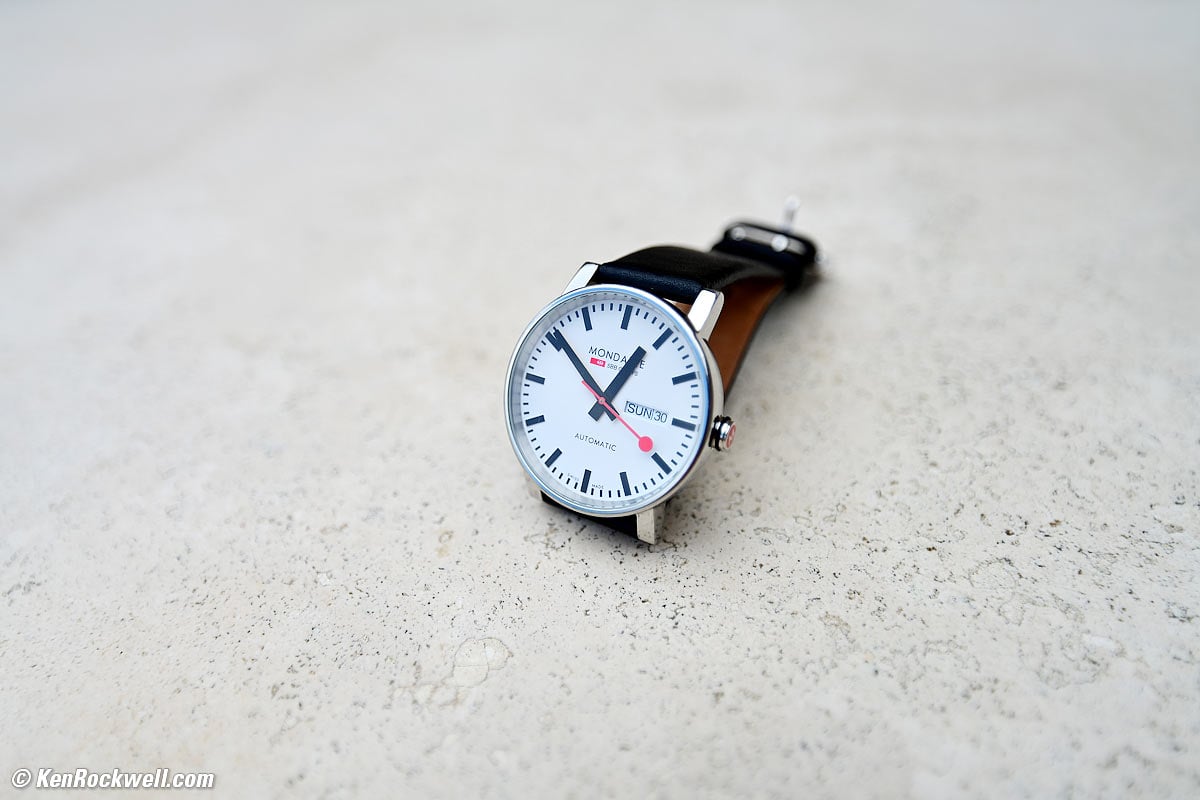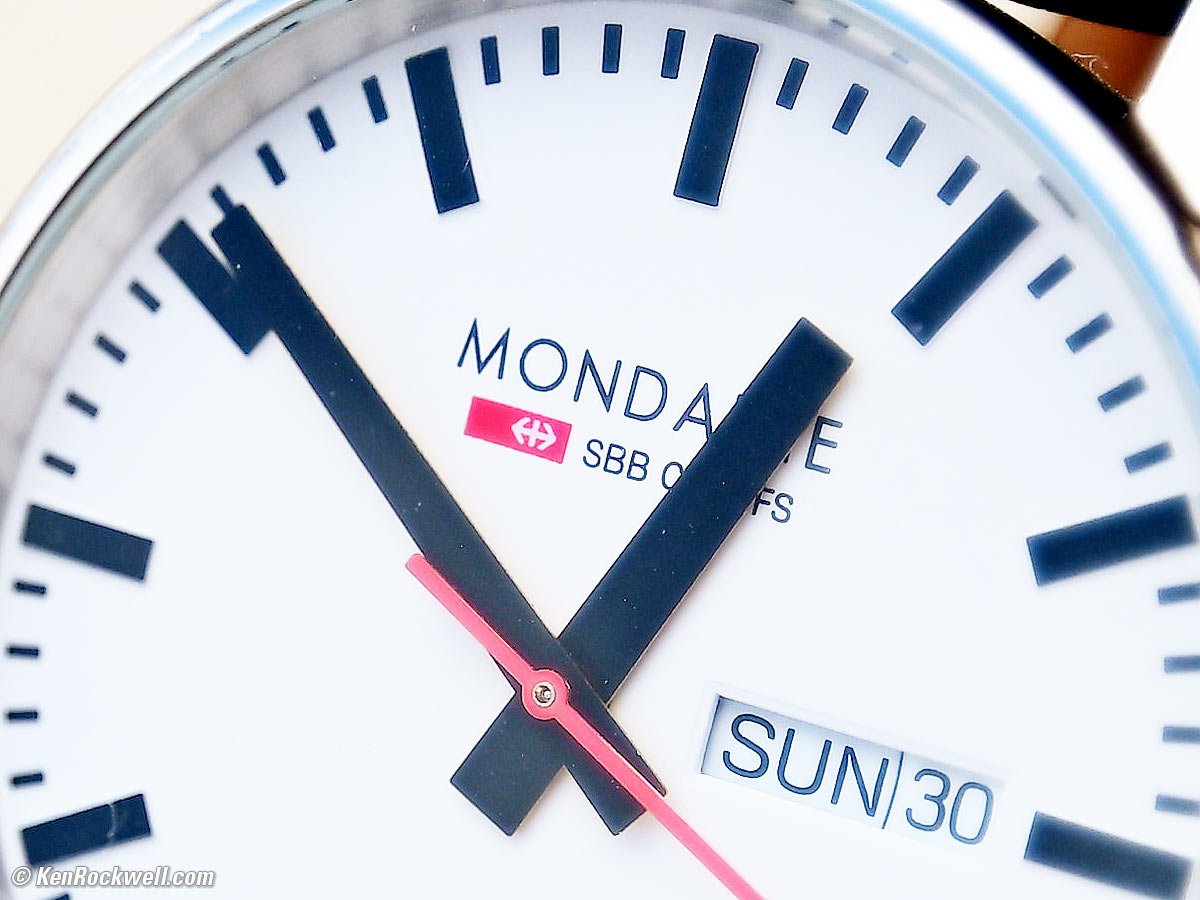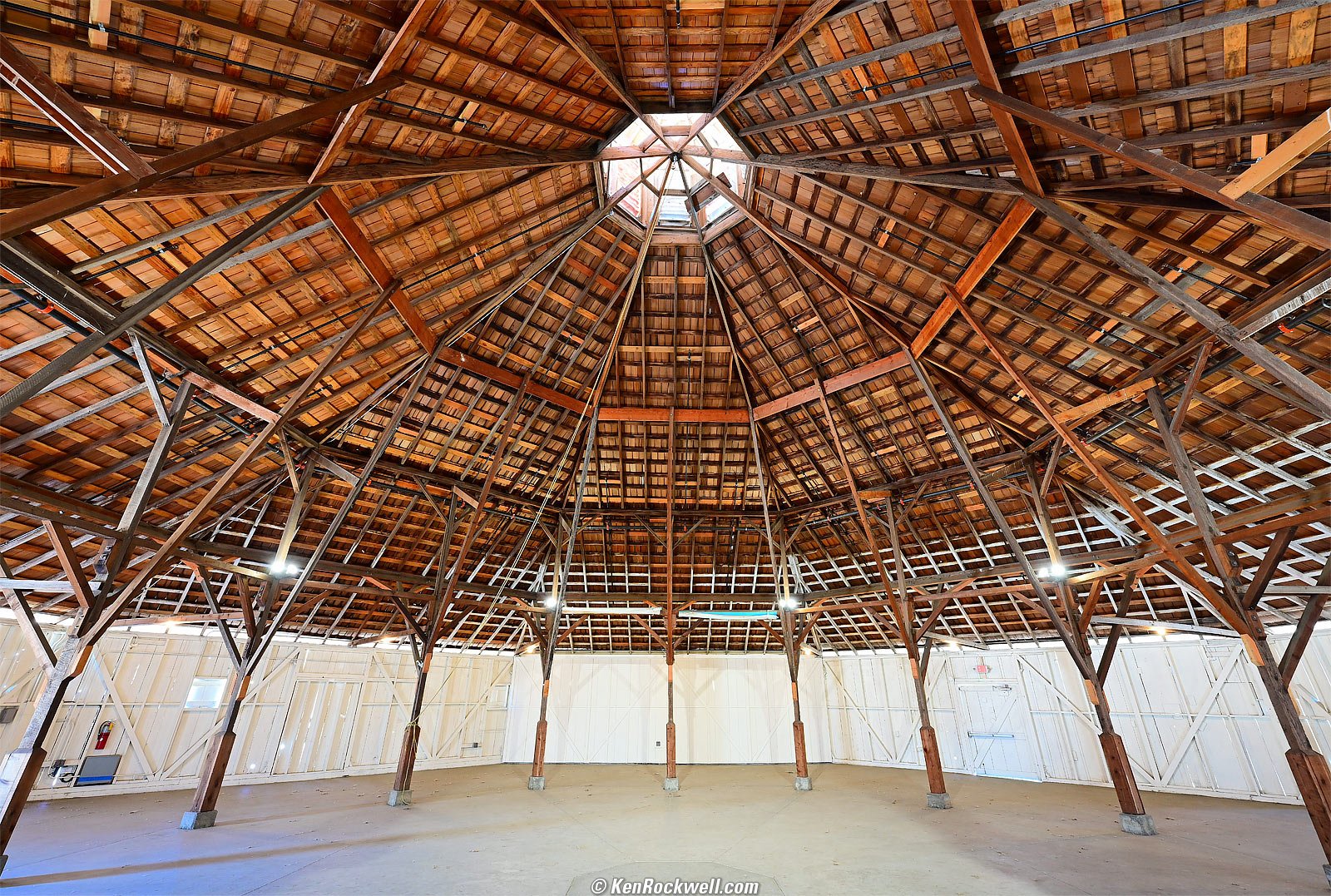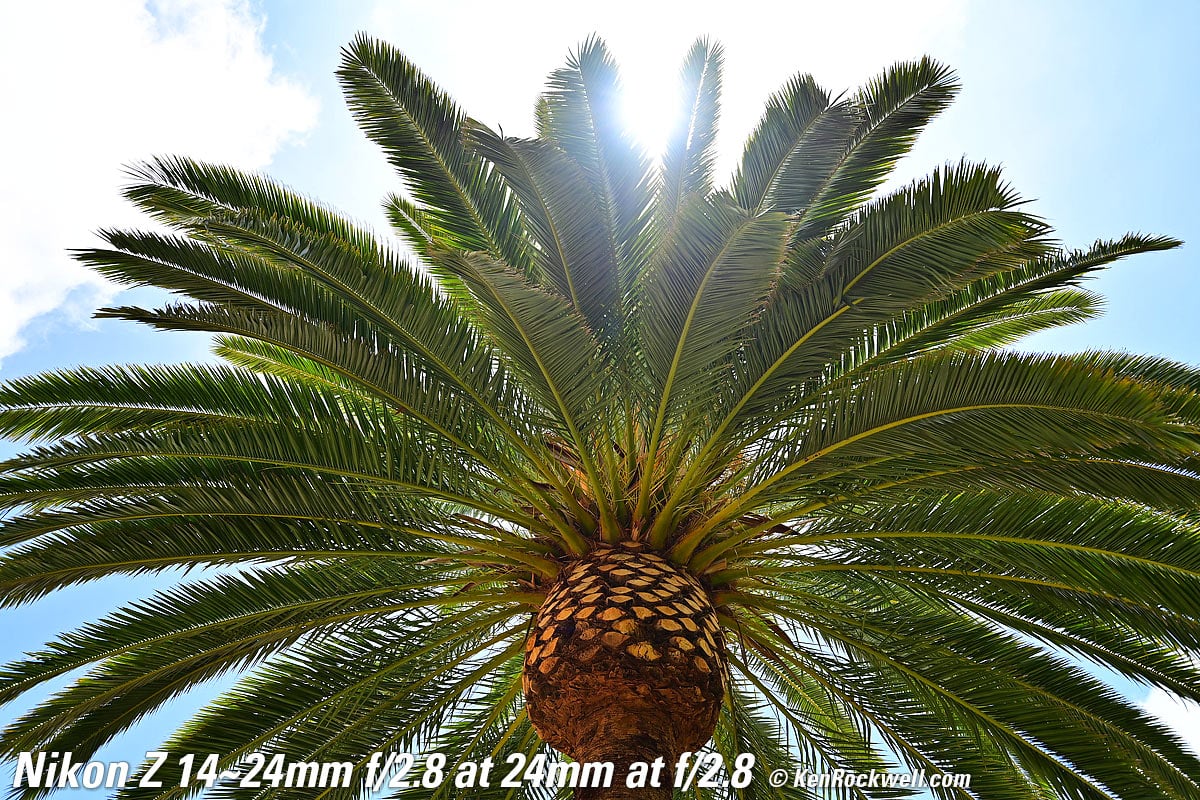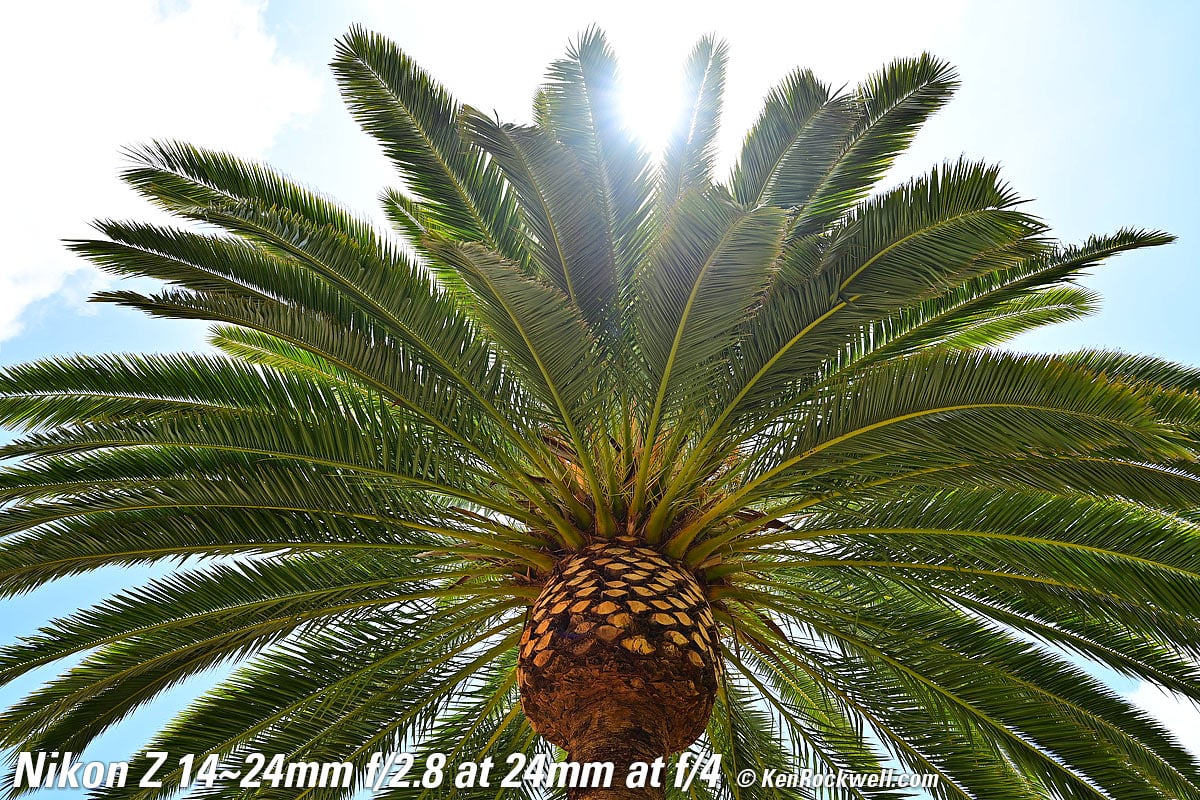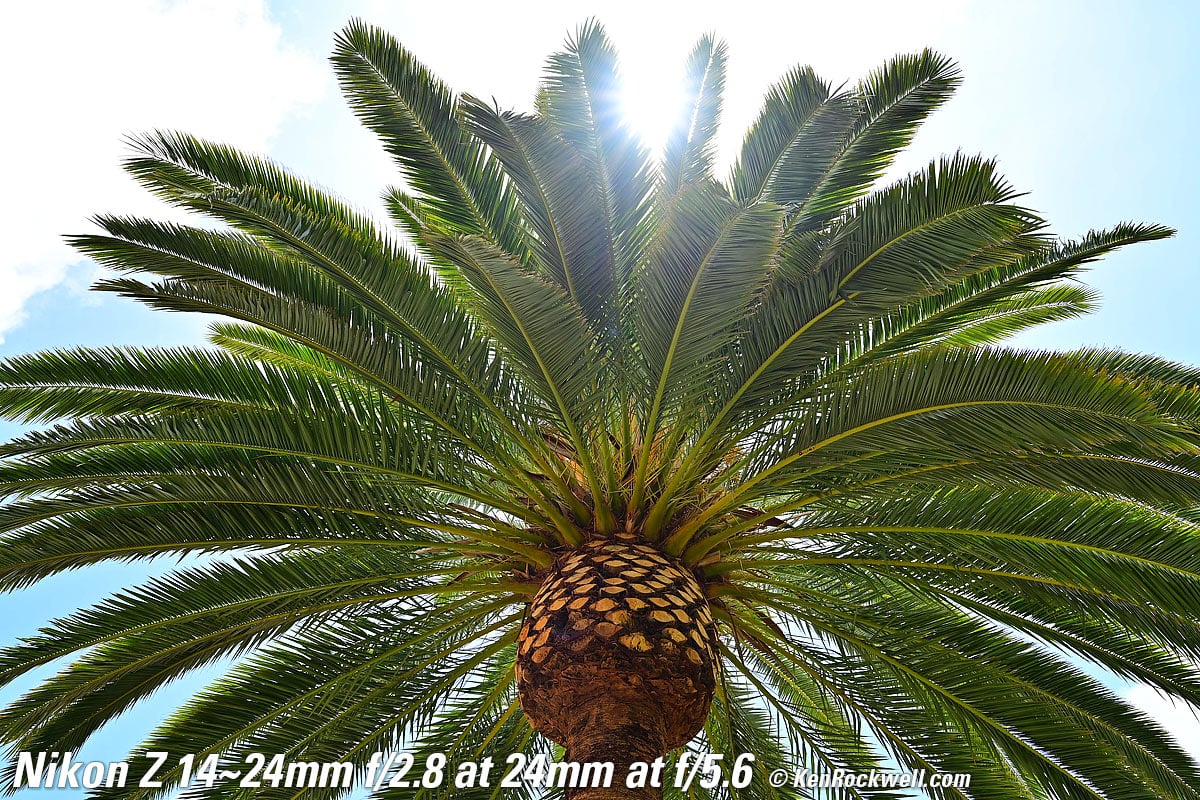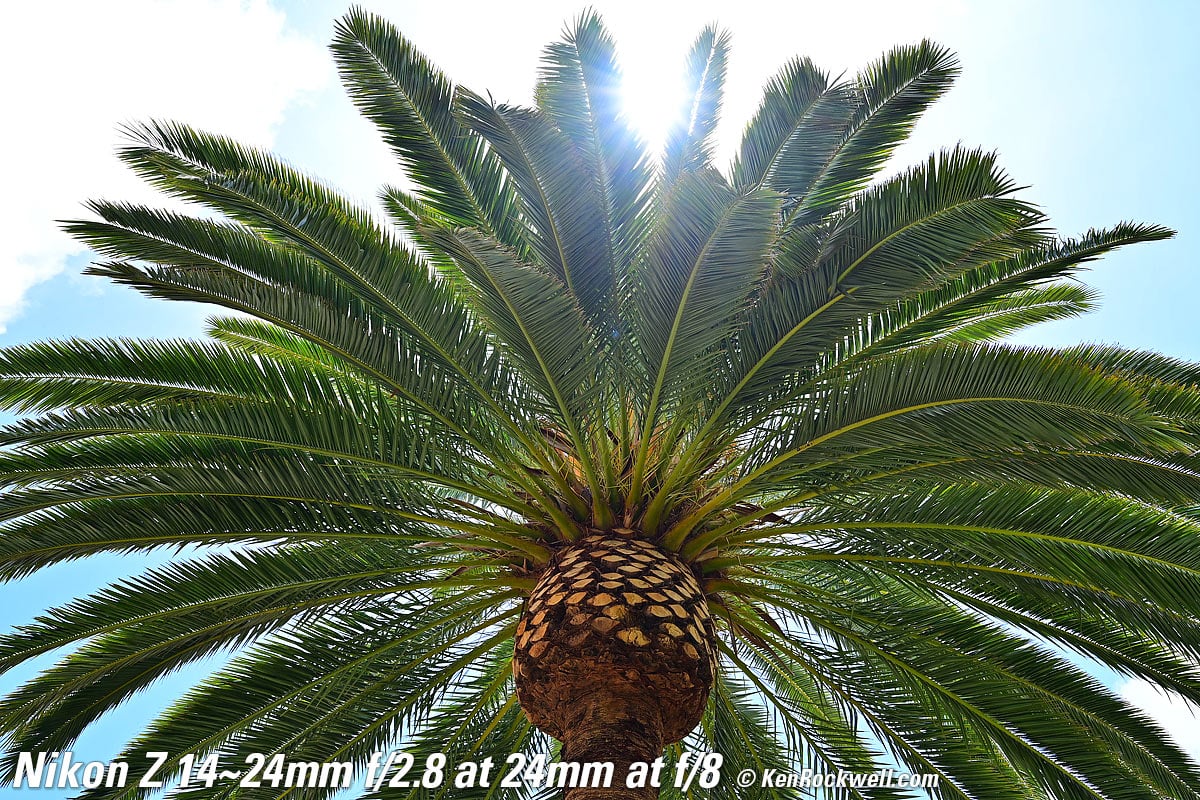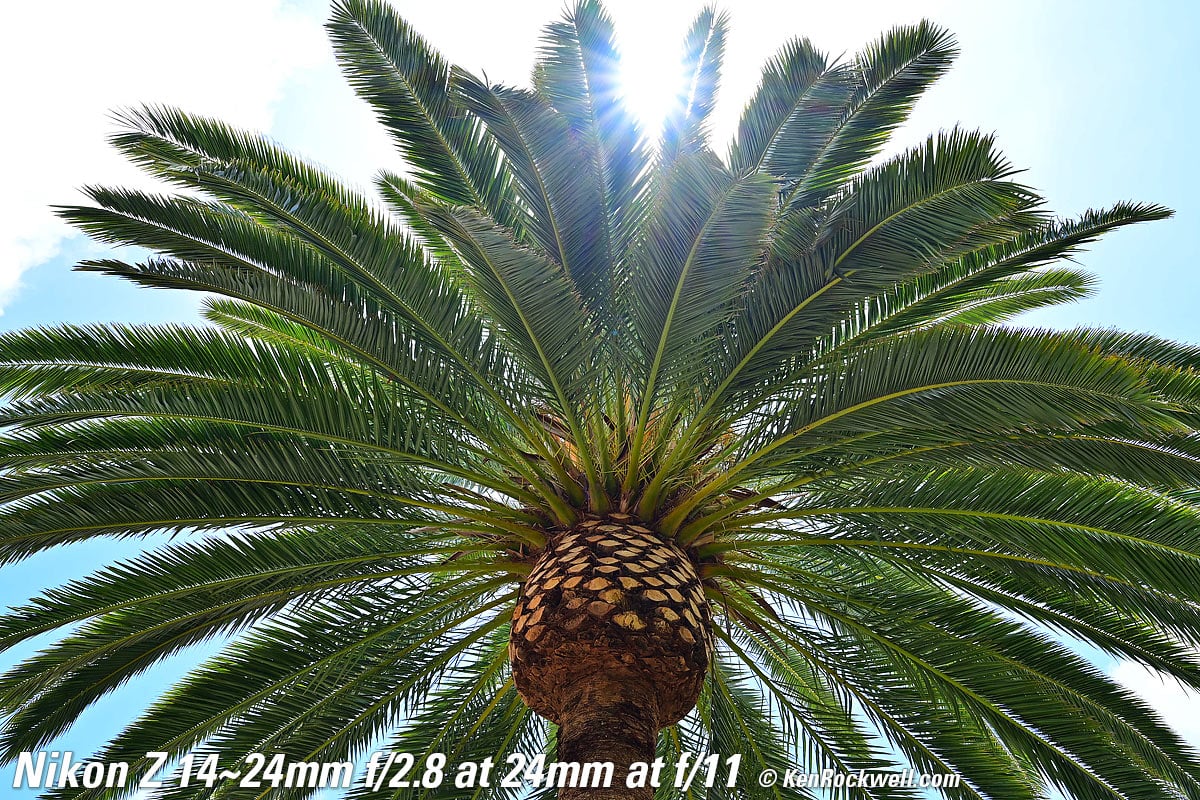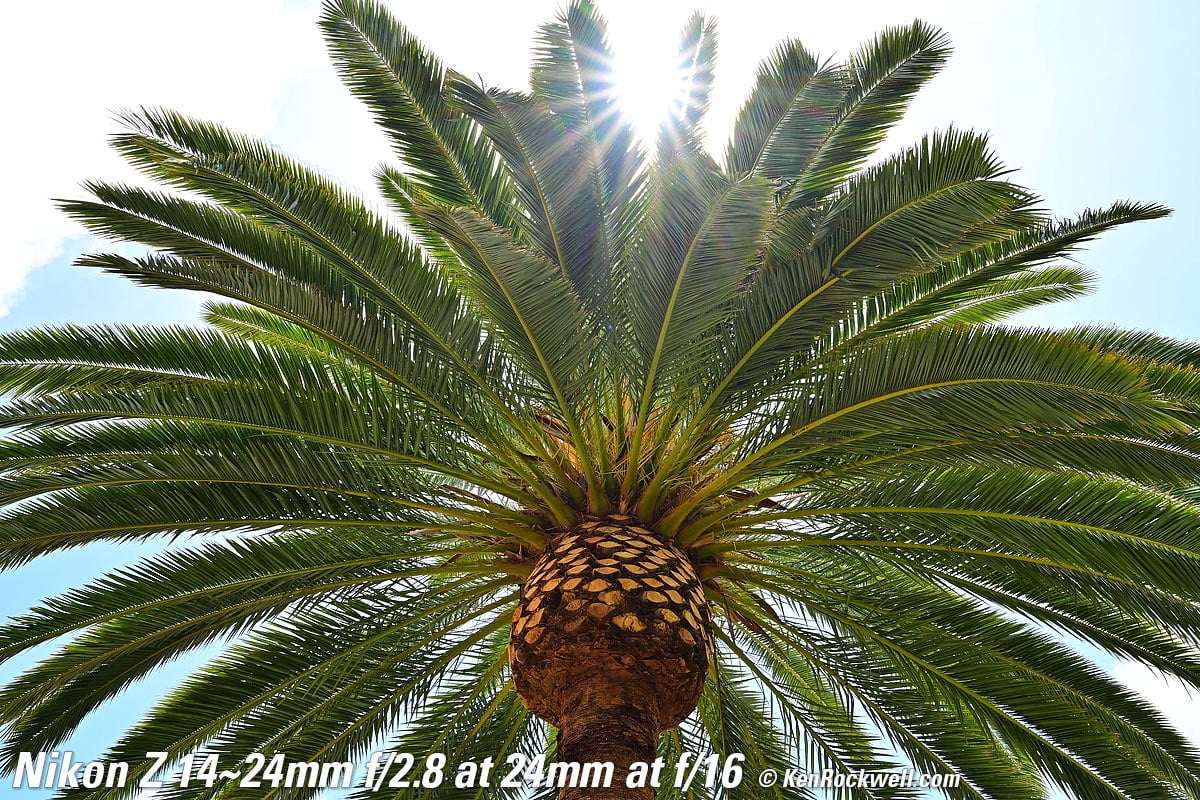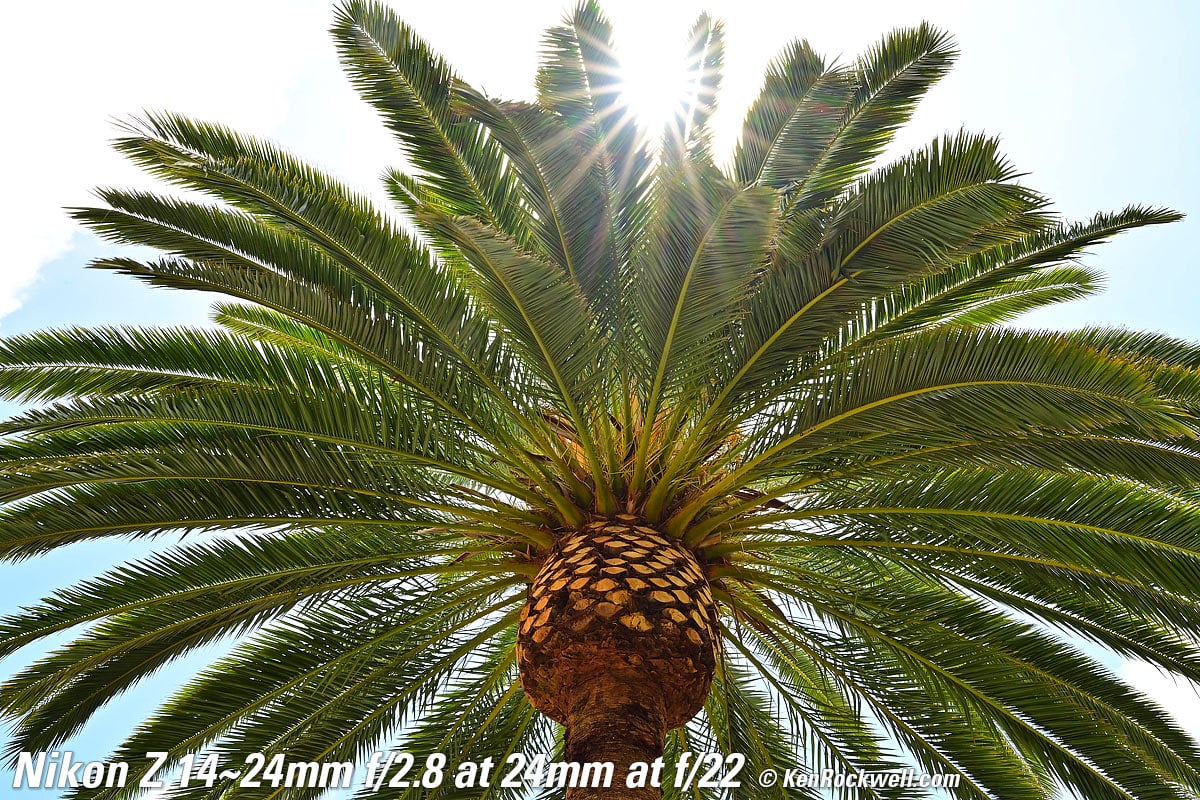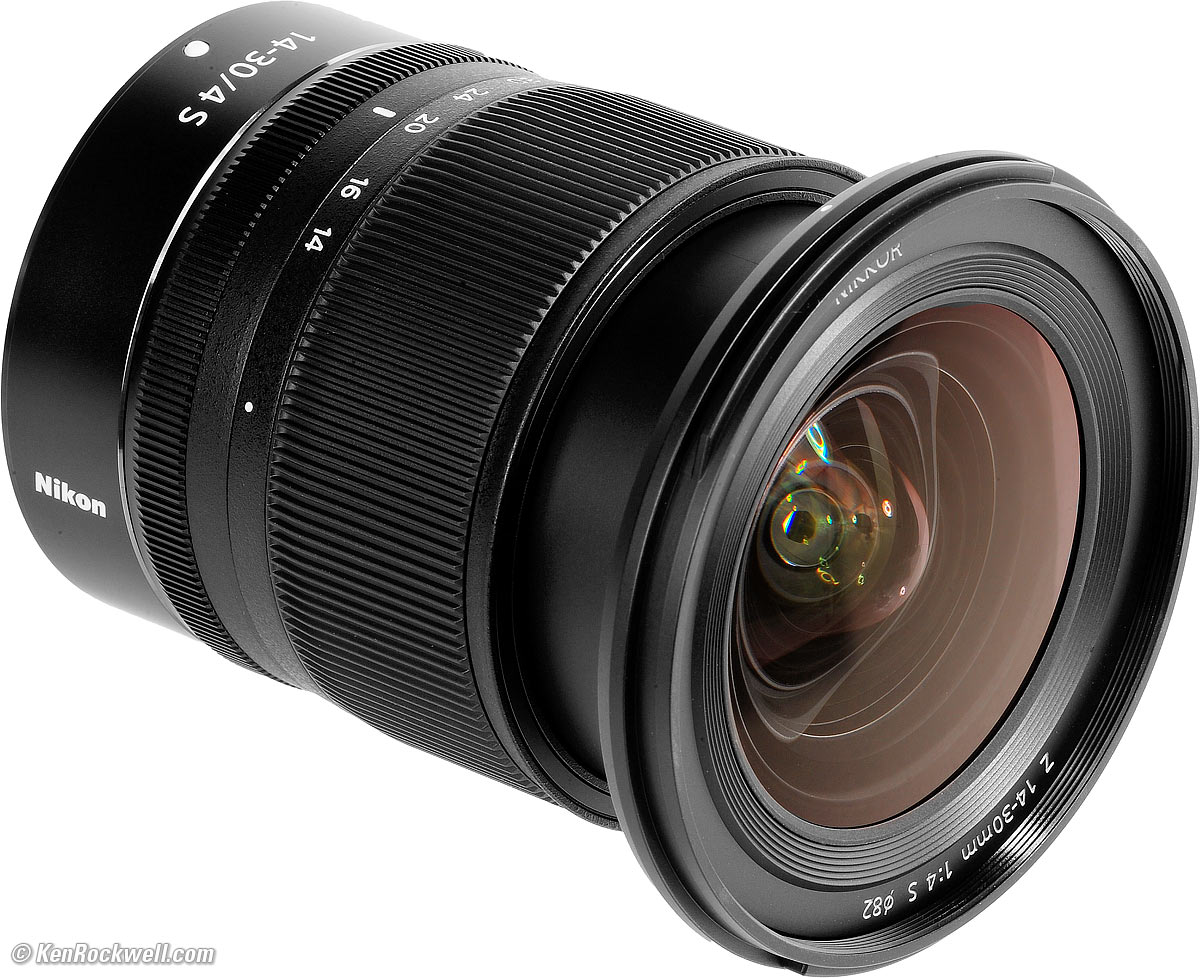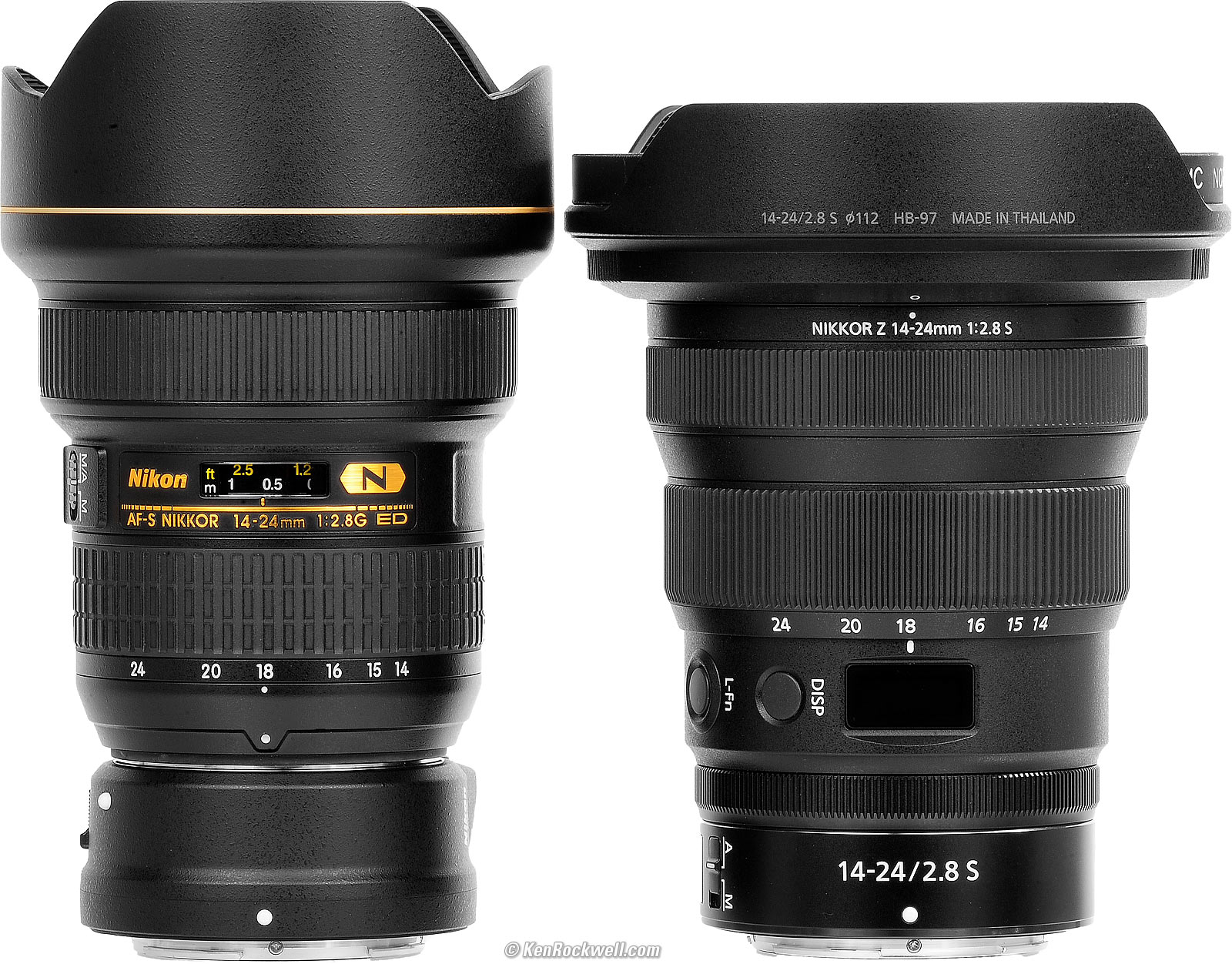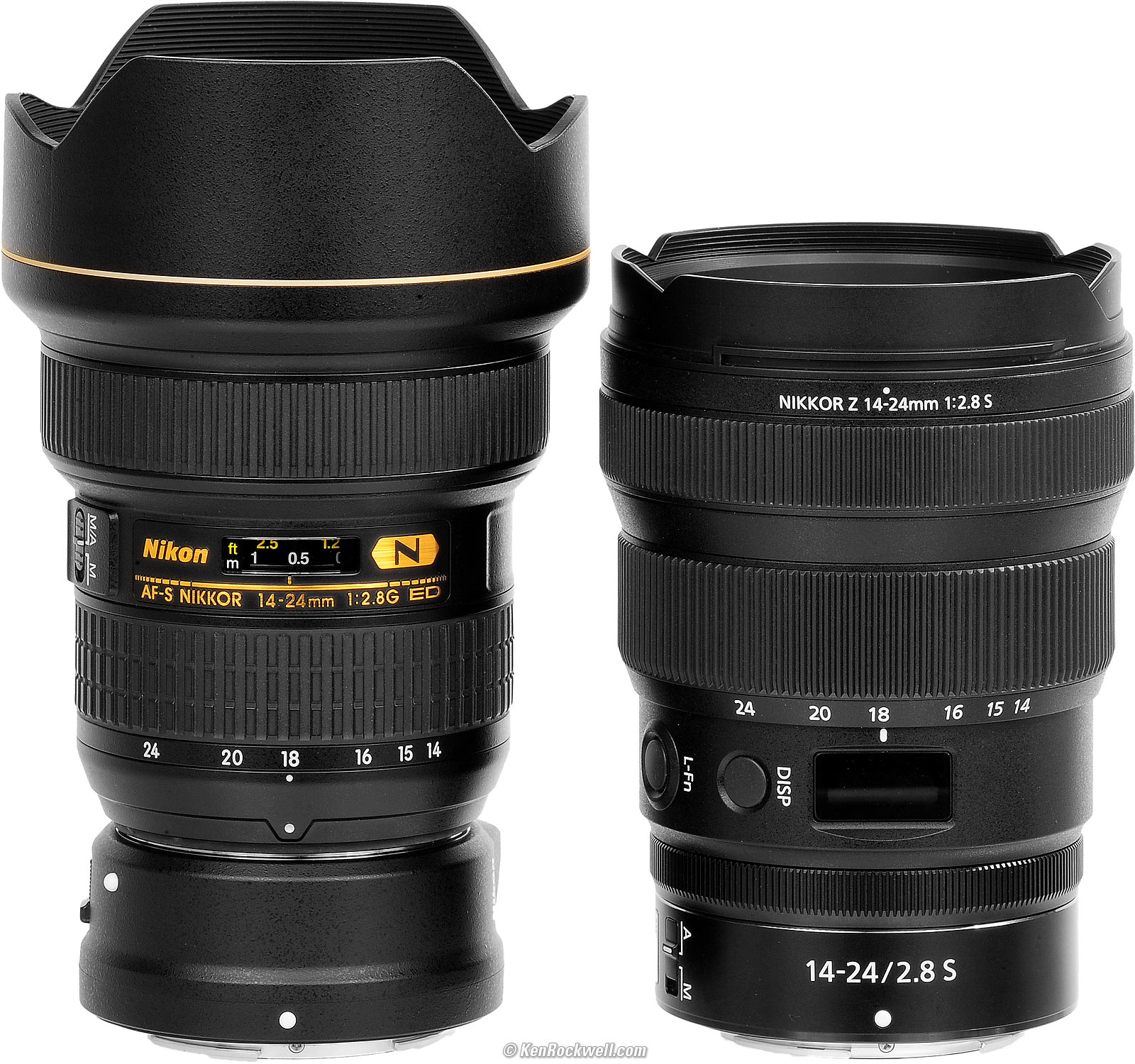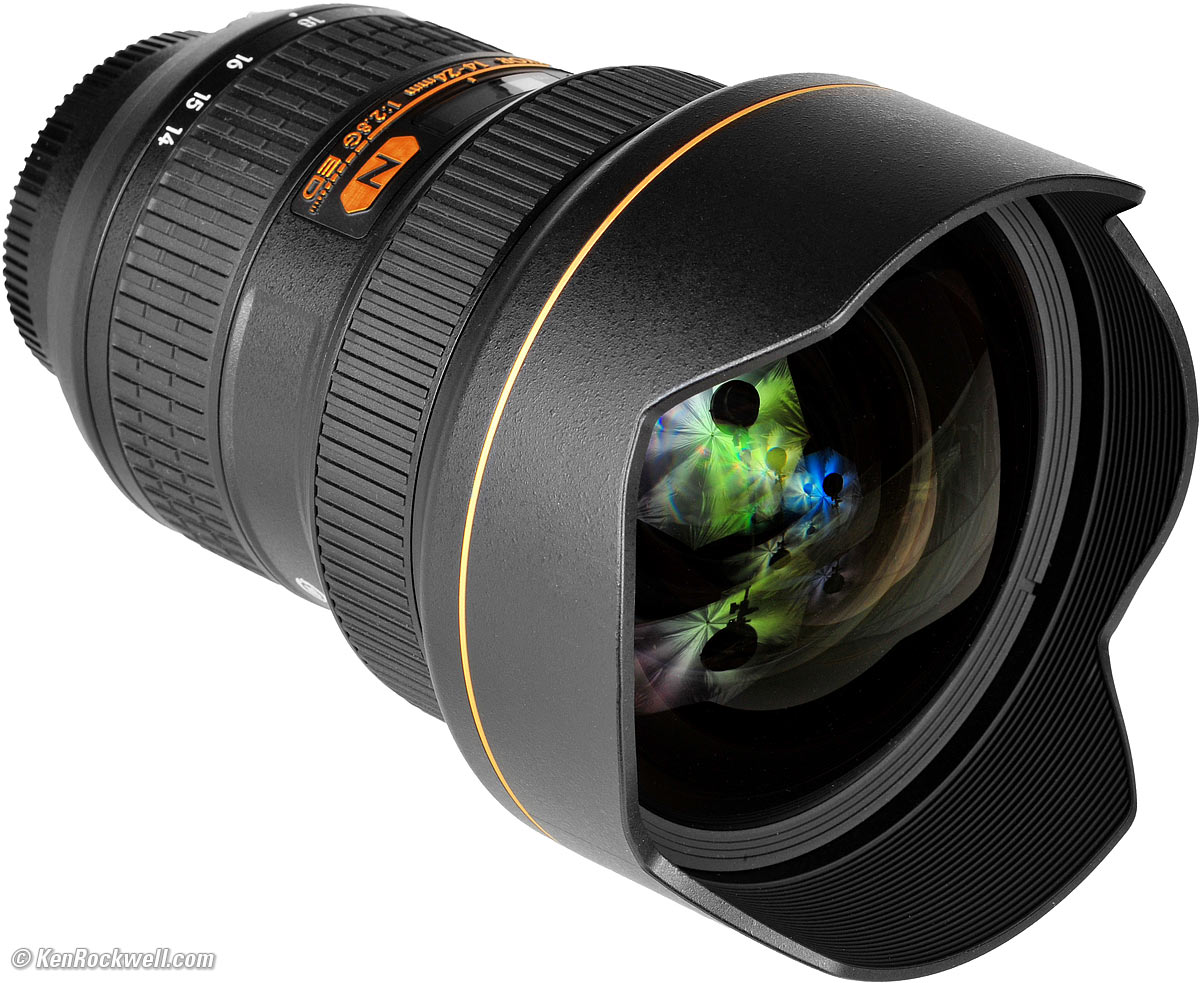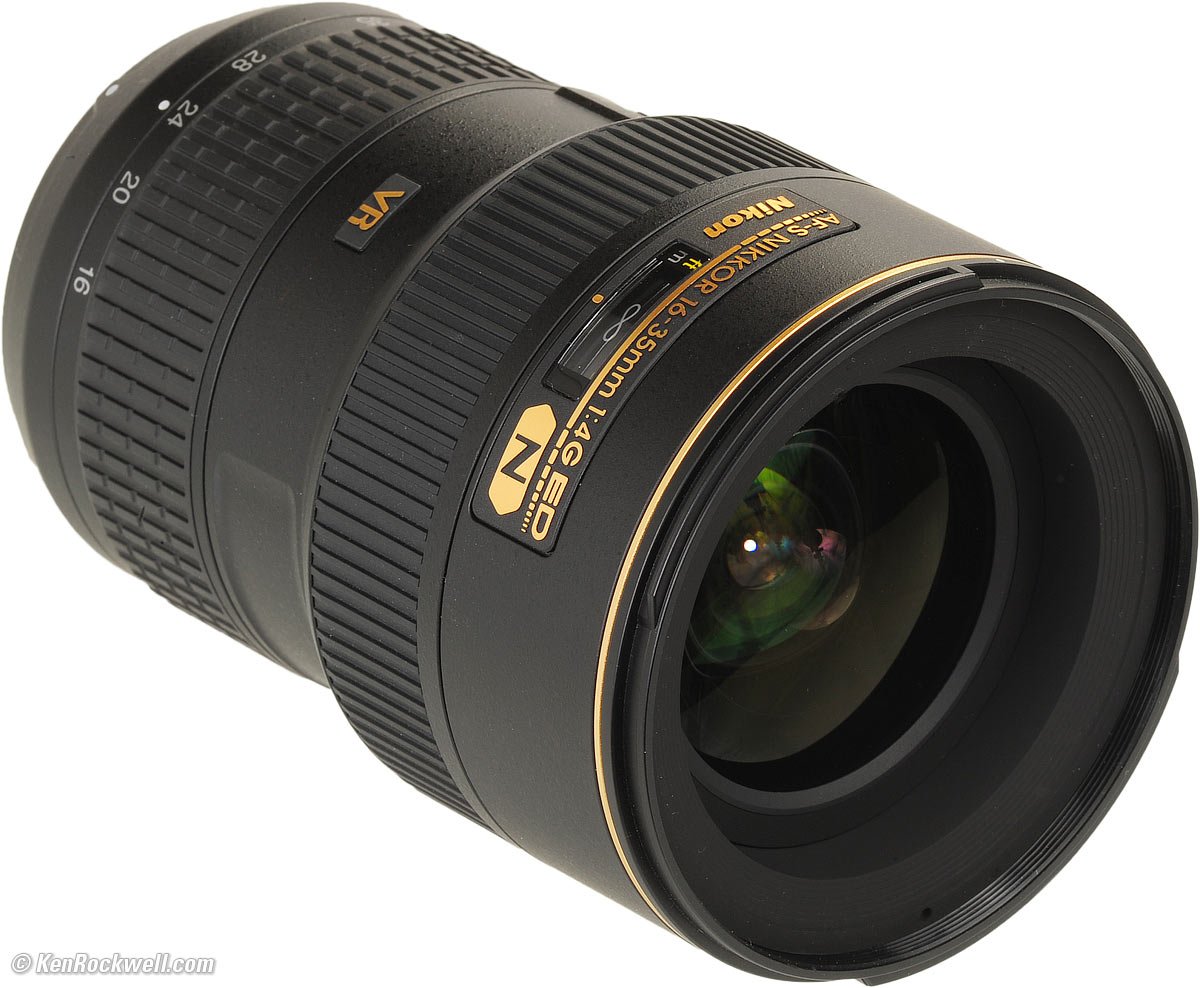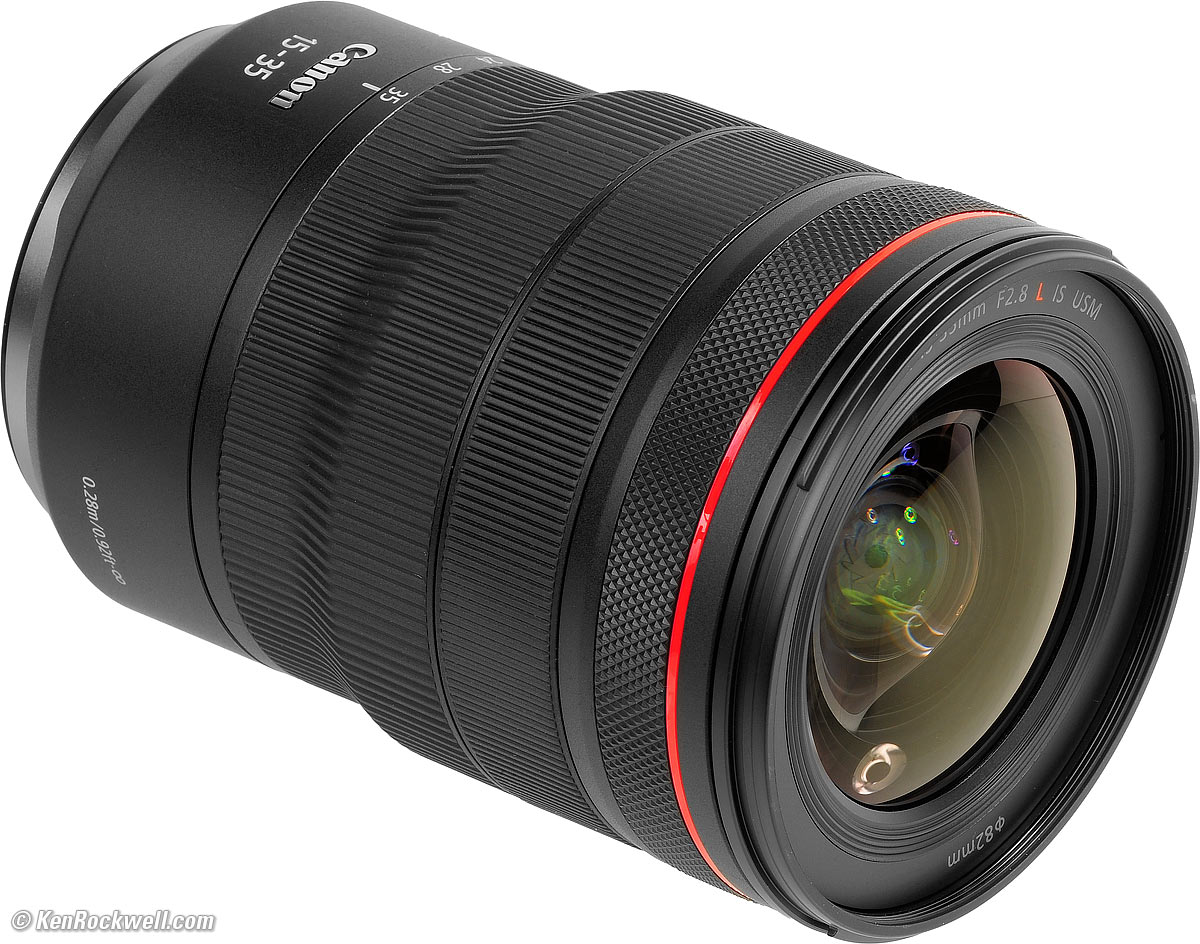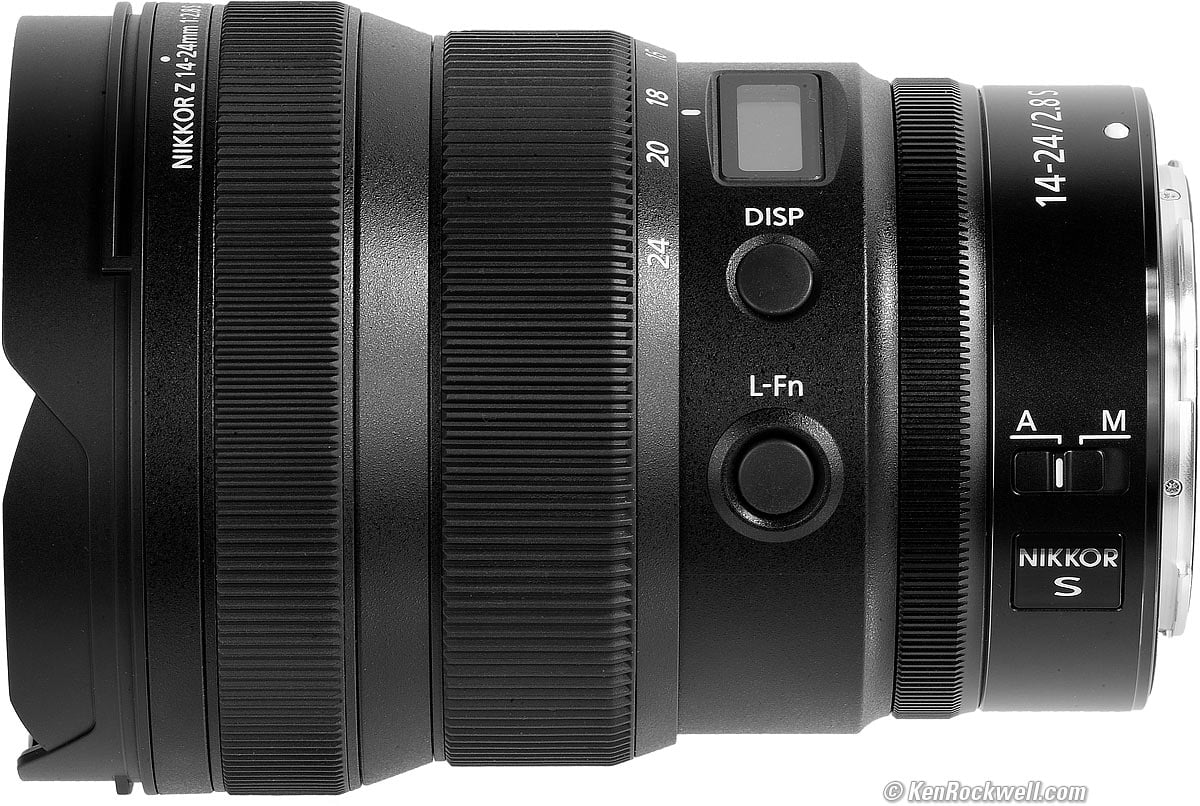Nikon Z 14-24mm f/2.8
Full-Frame Ultra-Ultrawide
Format Compatibility Specifications
USA Version Performance Compared
Z9 Z8 Z7 II Z6 II Zf Z7 Z6 Z5 Z fc Z50 Z30
Z System Z Lenses All Nikon Lenses Flash
Nikon Z 14-24mm f/2.8 (takes 112mm filters when used with the included HB-97 hood and/or rear gel filters, 22.8 oz./647g, 0.9'/0.28m close focus, $2,297). bigger. I got mine at B&H. I'd also get it at Adorama, at Amazon or at Crutchfield, or about $1,850 used if you know How to Win at eBay.
This 100% all-content, junk-free website's biggest source of support is when you use those or any of these links to my personally approved sources I've used myself for way over 100 combined years when you get anything, regardless of the country in which you live. Nikon does not seal its boxes in any way, so never buy at retail or any other source not on my personally approved list since you'll have no way of knowing if you're missing accessories, getting a defective, damaged, returned, non-USA, store demo or used lens — and all of my personally approved sources allow for 100% cash-back returns for at least 30 days if you don't love your new lens. I've used many of these sources since the 1970s because I can try it in my own hands and return it if I don't love it, and because they ship from secure remote warehouses where no one gets to touch your new lens before you do. Buy only from the approved sources I've used myself for decades for the best prices, service, return policies and selection.
July 2022 Nikon Mirrorless Mirrorless Lenses All Nikon Lenses Nikon Flash All Reviews
Sample Images top
Format Compatibility Specifications
USA Version Performance Compared
More samples throughout this review at Bokeh, Distortion, Macro, Sharpness, Spherochromatism and Sunstars.
All shot hand-held as BASIC ★ JPGs; no tripods, no RAW files, NORMAL or FINE JPGs were used or needed.
Carnegie Library, San Luis Obispo, California, 8:47 P.M, 02 June 2021. Nikon Z7 II and Nikon Z 14-24mm f/2.8 at 18 mm (40mm equivalent on 6×6 cm Hasselblad) wide-open at f/2.8 hand-held at ⅛ at Auto ISO 1,400, -0.7 stops exposure compensation (LV 2.2), Perfectly Clear. bigger or full-resolution.
I would have to expose Velvia 50 for two and a half minutes at f/11 in my Hasselblad. I don't have the time for this, and certainly no patience to haul a tripod around downtown all night when I can get the same results hand-held with a Z7 II — and much better color than scanned Velvia.
RAINBOW Trees, San Luis Obispo, California, 8:43 P.M, 02 June 2021. Nikon Z7 II and Nikon Z 14-24mm f/2.8 at 14mm wide-open at f/2.8 hand-held at ⅛ at Auto ISO 250 (LV 4.6), Perfectly Clear. bigger or full-resolution.
Old Mission San Luis Obispo at Dusk, 8:41 P.M, 02 June 2021. Nikon Z7 II and Nikon Z 14-24mm f/2.8 at 16mm (38mm equivalent on 6×6 cm Hasselblad) wide-open at f/2.8 hand-held at 1/15 at Auto ISO 450 (LV 4.7), Perfectly Clear. bigger.
I so love being able to point-and-shoot this night work rather than having to hump my Hasselblad and a tripod all over. I'd have to expose for f/16 at 32 seconds on Velvia 50, and it's a pain trying to muscle a tripod into exactly the right point in 3D space to get this composition, which is trivial hand-held.
Pismo Beach Hotel, 8:44 P.M, 01 June 2021. Nikon Z7 II and Nikon Z 14-24mm f/2.8 at 18.5mm at f/2.8 hand-held at ¼ second at Auto ISO 200, -0.7 stops exposure compensation (LV 4.0), Perfectly Clear. bigger, full-resolution or camera-original © file.
I've been shooting at night for almost 50 years. Back in 1971 it was a real pain in the neck, requiring a tripod and having to guess at exposure because most CdS meters couldn't read this low unless you played some tricks with them (meter the white and subtract two stops, for instance).
These night shots are easy hand-held today with this gear: just point, hold still and shoot! Metering and auto exposure and and auto ISO all work great once you set them to taste. Also back in the day there were no lenses this wide, and even if there were in other formats, they certainly weren't f/2.8 and there were no stabilized lenses or cameras. Today we can leave our tripods at home.
A trick I use to get all this dynamic range from bright neon to dark shadows is to expose for the highlights (use the most exposure I can that doesn't lose the highlights) and then use Perfectly Clear to bring up the shadows without losing the highlights. Easy, and as you can see it works great from BASIC ★ JPG files, no raw needed!
Hotel San Luis Obispo at Dusk, 8:31 P.M, 03 June 2021. Nikon Z7 II and Nikon Z 14-24mm f/2.8 at 14mm wide-open at f/2.8 hand-held at 1/15 at Auto ISO 220, -0.7 stops exposure compensation (LV 5¾), Perfectly Clear. bigger or full-resolution.
Just Before Bike Night, Higuera Street, San Luis Obispo, California, 9:31 P.M, 03 June 2021. Nikon Z7 II and Nikon Z 14-24mm f/2.8 at 14mm at f/2.8 at 1/15 at Auto ISO 1,250, -0.7 stops exposure compensation (LV 3.2), Perfectly Clear. bigger, or full-resolution.
Woodstock's Pizza, San Luis Obispo, California, 3:25 P.M, 03 June 2021. Nikon Z7 II and Nikon Z 14-24mm f/2.8 at 24mm at f/2.8 at 1/25 at Auto ISO 1,000, -0.3 stops exposure compensation (LV 4.3), Perfectly Clear. bigger or full-resolution.
Green Field and Farmhouse, Camarillo, California, 5:21 P.M, 04 June 2021. Nikon Z7 II and Nikon Z 14-24mm f/2.8 at 24mm at f/16 hand-held at 1/30 at Auto ISO 64, -0.3 stops exposure compensation (LV 13.6), Perfectly Clear, perspective correction in Photoshop CS6. bigger or camera-original © file.
Introduction top
Format Compatibility Specifications
USA Version Performance Compared
|
I buy only from these approved sources. I can't vouch for ads below. |
This is Nikon's fast ultra-ultrawide zoom for their full-frame mirrorless Z cameras. The 14-24mm range is quite limited; for most people it's not as useful as the Z 14-30mm f/4 or Canon's RF 15-35mm f/2.8 or Nikon's 16-35mm f/4 VR lens. This 14-24mm is for people who really need f/2.8 rather than f/4, and are willing to pay for it.
This new 14-24/2.8 is much smaller, lighter and takes filters compared to 2007's AF-S 14-24mm f/2.8, and it's at least as sharp.
This new lens has no stabilization. You're at the mercy of what little in-body stabilization your body may be able to provide, and no sensor-shift stabilization system can stabilize the corners at the same time as the center with ultra-ultrawide lenses.
Just turn the focus ring at any time for instant manual-focus override.
While it has only a narrow 1.7× 14-24mm zoom range making it much less useful than a 16-35mm lens, this little lens should be a great addition to any bag, unless you prefer the more portable, more practical and much less expensive Z 14-30mm f/4.
I got my Z 14-24mm f/2.8 at B&H. I'd also get it at Adorama, at Amazon or at Crutchfield, or used at eBay if you know How to Win at eBay.
New intro top
 Nikon's first f/2.8 ultra-wide zoom for their mirrorless Z cameras.
Nikon's first f/2.8 ultra-wide zoom for their mirrorless Z cameras.
 First 14mm f/2.8 lens that can sort of take a front screw-in filter with the included HB-97 hood.
First 14mm f/2.8 lens that can sort of take a front screw-in filter with the included HB-97 hood.
 First ultra-ultrawide lens with a digital display.
First ultra-ultrawide lens with a digital display.
 Comes with both a little HB-96 hood and a larger HB-97 hood which holds 112mm screw-in filters.
Comes with both a little HB-96 hood and a larger HB-97 hood which holds 112mm screw-in filters.
 Nikon 112mm NC (no color) Filter and 112mm and Circular Polarizing Filter II released along with this lens. Warning: avoid using polarizers with ultra wide lenses.
Nikon 112mm NC (no color) Filter and 112mm and Circular Polarizing Filter II released along with this lens. Warning: avoid using polarizers with ultra wide lenses.
Good intro top
 Super sharp.
Super sharp.
 Remarkably resistant to flare and ghosts.
Remarkably resistant to flare and ghosts.
 Stops down to f/22.
Stops down to f/22.
 Fluorine coating to resist dirt and smudges.
Fluorine coating to resist dirt and smudges.
 Programmable L-Fn button.
Programmable L-Fn button.
 Claimed dirt, dust and moisture resistance.
Claimed dirt, dust and moisture resistance.
 Full-time instant manual-focus override.
Full-time instant manual-focus override.
 First 14mm f/2.8 lens that can take 112mm screw-in filters if you use the included HB-97 hood.
First 14mm f/2.8 lens that can take 112mm screw-in filters if you use the included HB-97 hood.
Bad intro top
 No in-lens stabilization, and no sensor-shift stabilization system can stabilize the corners at the same time as the center with ultra-ultrawide lenses.
No in-lens stabilization, and no sensor-shift stabilization system can stabilize the corners at the same time as the center with ultra-ultrawide lenses.
 Limited zoom range of only 14-24mm or 1.7×. Not much change in the image as zoomed.
Limited zoom range of only 14-24mm or 1.7×. Not much change in the image as zoomed.
 Big, but still much smaller than the F-mount AFS 14-24mm f/2.8.
Big, but still much smaller than the F-mount AFS 14-24mm f/2.8.
 Heavy, but still much lighter than the F-mount AFS 14-24mm f/2.8.
Heavy, but still much lighter than the F-mount AFS 14-24mm f/2.8.
 Expensive, and even more expensive than the F-mount AFS 14-24mm f/2.8.
Expensive, and even more expensive than the F-mount AFS 14-24mm f/2.8.
 Takes huge 112mm filters rather than normal-sized ones - but's that's better than the F-mount AFS 14-24mm f/2.8 which takes no filters at all.
Takes huge 112mm filters rather than normal-sized ones - but's that's better than the F-mount AFS 14-24mm f/2.8 which takes no filters at all.
 Production dumped to Thailand, not made domestically in Japan.
Production dumped to Thailand, not made domestically in Japan.
Missing intro top
 No Image Stabilization; it's hoping in-camera stabilization will help you, but sensor-shifting can't stabilize the corners of ultra-ultrawides due to geometry; the corners would have to shift 50% more than the center at 14mm!
No Image Stabilization; it's hoping in-camera stabilization will help you, but sensor-shifting can't stabilize the corners of ultra-ultrawides due to geometry; the corners would have to shift 50% more than the center at 14mm!
Nikon Z 14-24mm f/2.8. bigger.
Format top
Format Compatibility Specifications
USA Version Performance Compared
I got my Z 14-24mm f/2.8 at B&H. I'd also get it at Adorama, at Amazon or at Crutchfield, or used at eBay if you know How to Win at eBay.
This is a full frame FX lens, and I'm reviewing it as such.
It works great on DX cameras, too, on which you may make the usual inferences - but the Z 16-50mm is a much more useful lens on the Z50.
Compatibility top
Format Compatibility Specifications
USA Version Performance Compared
I got my Z 14-24mm f/2.8 at B&H. I'd also get it at Adorama, at Amazon or at Crutchfield, or used at eBay if you know How to Win at eBay.
This lens works only on Nikon's Z-series mirrorless cameras.
It does not so much as even mount on any other camera.
Specifications top
Format Compatibility Specifications
USA Version Performance Compared
I got my Z 14-24mm f/2.8 at B&H. I'd also get it at Adorama, at Amazon or at Crutchfield, or used at eBay if you know How to Win at eBay.
Name specifications top
Nikon calls this the Nikon NIKKOR Z 14-24mm f/2.8 S:
NIKKOR: Nikon's brand name for all their lenses.
Z: For Nikon's mirrorless cameras.
S: Subliminally suggests sexual satisfaction. The "S" designation has no other purpose than subliminal seduction; Nikon and electronics and automobile and every kind of marketer have been using letters like "S" and "X" in model numbers since the 1940s for this same reason. Nikon called their first 1946 rangefinder lens mount the "S" mount, then went whole-hog to the "F" SLR mount in 1959, used "S" again when they updated their AI lenses to AI-"S" in 1983, created AF-"S" SWM lenses in 1998 and here it is again.
Also has:
ARNEO Coat: Magic anti-reflection coating that's especially good for use in high-speed lenses.
E: Electronic diaphragm for silent operation.
AF-P: Stepper (Pulse) STM autofocus motor: silent and ultra fast.
D: Couples distance information to the 3D Matrix Meter.
ED: Magic Extra-low Dispersion glass for reduced secondary chromatic aberration.
IF: Internal focusing; nothing moves externally as focused.
Aspherical: Specially curved glass elements for sharper pictures.
G: Gelded; has no aperture ring.
Nano Crystal Coat (N): Magic anti-reflection coating that has a variable index of refraction that's far more effective against ghosts and internal reflections than traditional multicoating.
∅112: 112mm filter thread inside the included HB-97 hood.
Optics specifications top
Nikon Z 14-24mm f/2.8 internal optical construction. Aspherical and ED elements.
16 elements in 11 groups.
4 ED extra-low dispersion elements, which help reduce secondary axial chromatic aberration.
3 aspherical elements.
Nikon Super Integrated multicoating (SIC) with ARENEO and Nano coatings claimed.
Fluorine coating to resist dirt and smudges.
Filters specifications top
112mm × 1.0mm thread pitch filter thread in the included HB-97 hood.
Nikon erroneously specifies 0.75mm thread pitch; I measured it and it's the standard 1.0mm thread pitch for this filter size.
Diaphragm specifications top
Nikon Z 14-24mm at 24mm. bigger.
9 rounded blades.
Electronically actuated.
Stops down to f/22.
Angles of View specifications top
114º ~ 84º diagonal on on FX.
90º ~ 61º diagonal on DX.
Focus Scale specifications top
Optional on external display.
Infinity Focus Stop specifications top
No.
Depth of Field Scale specifications top
No, but could be optional on external display some day.
Who cares; look through your live-view finder.
Infrared Focus Index specifications top
No.
Close Focus specifications top
0.92 feet (11 inches or 0.28 meters) from the image plane (much closer to the front of the lens).
Maximum Reproduction Ratio specifications top
1:7.7 (0.13 ×).
Reproduction Ratio Scale specifications top
No.
Image Stabilizer specifications top
None.
Hoods specifications top
Included HB-96 hood and Included HB-97 hood. bigger.
Nikon Z 14-24mm f/2.8 and included HB-97 hood. bigger.
The 14-24mm comes with two hoods:
The standard HB-96 hood covers just the lens.
The larger HB-97 hood holds a big 112mm filter and takes a huge LC-K104 cap.
Both have spring-loaded locking pawls so they will stay put, and come off easily when you want them to.
Caps specifications top
Front Caps
Included Nikon LC-Z1424 basic front cap. bigger.
LC-Z1424 for use with just the lens alone or either of the hoods.
Note the cutouts on the bottom to fit the scalloped cutouts on the front of the lens.
Included Mongo-Sized Nikon LC-K104 front cap. bigger.
LC-K104 for use with the larger HB-97 112mm filter-holding hood.
Rear Cap
LF-N1 standard Z-mount rear cap.
Case specifications top
Nikon CL-C2 case. This is a case? bigger.
CL-C2 "case," included.
They're kidding, right? It's just a bag, and not even padded. Geesh.
Size specifications top
3.48" ø maximum diameter × 4.90" extension from flange.
88.5 mm ø maximum diameter × 124.5 mm extension from flange.
Weights specifications top
22.830 oz. (647.3g) actual measured weight.
Rated 22.9 oz. (650 g).
Big HB-97 hood: 1.775 oz. (50.3g), actual measured weight.
LC-K104 huge front cap: 2.140 oz. (60.6g), actual measured weight.
Big HB-97 hood, Tokina 112mm filter and Nikon LC-K104 big cap: 7.270 oz. (206.1g) measured.
Announced specifications top
12:32 AM, Wednesday, 16 September 2020, NYC time.
Promised for specifications top
November 2020.
Included specifications top
Special LC-Z1424 front cap to cover the lens itself, or with the smaller HB-96 hood.
Special LC-K104 front cap to cover the larger HB-97 hood.
Smaller HB-96 hood.
Larger HB-97 hood.
LF-N1 standard Z-mount rear cap.
CL-C2 case.
Box Details, Nikon Z 14-24mm f/2.8. bigger.
Nikon's Model Number specifications top
20097.
Quality specifications top
Made in Thailand. bigger.
Made in Thailand.
Price, U. S. A. specifications top
December 2022
$2,297 at Adorama, at Amazon, at B&H and at Crutchfield.
About $1,850 used if you know How to Win at eBay.
July 2021 ~ July 2022
$2,397 at Adorama, at Amazon, at B&H and at Crutchfield.
May ~ June 2021
$2,197 at Adorama, at Amazon, at B&H and at Crutchfield.
September 2020
$2,397 at introduction.
Box, Nikon Z 14-24mm f/2.8. bigger.
Getting a Legitimate U. S. A. Version top
Format Compatibility Specifications
USA Version Performance Compared
I got my Z 14-24mm f/2.8 at B&H. I'd also get it at Adorama, at Amazon or at Crutchfield, or used at eBay if you know How to Win at eBay.
This section applies in the U. S. A. only.
You need a USA Warranty Card, and the serial number must match the one on the bottom of your lens, otherwise you have no warranty.
U. S. A. Warranty Card. bigger.
If you don't have this card, if the card doesn't say "VALID IN THE CONTINENTAL UNITED STATES" or the serial number on the card doesn't match the one on your lens exactly, you got ripped off with a gray market version from another country. All legitimate lenses come with printed warranty cards, even if you prefer to register online. (The serial number on the box doesn't have to match, but if it doesn't it means you bought from a shady dealer who took lenses out of boxes and then resold these used lenses as new.)
Did you notice the clever nod to ancient computer technology? This is printed on tractor-fed paper with tear-off sides and dot-matrix printing of model and serial numbers! If your card lacks these side perforations, beware. Everyone counterfeits laser holograms, but few people have dot-matix printers floating around to fake these.
Nikon stopped offering 5-year lens warranties in 2021 in an effort to save themselves money at our expense.
Always be sure to check your box, warranty card and serial numbers while you can still return it, or just don't buy from unapproved sources or at retail so you'll be able to have your camera serviced and get free updated firmware as needed.
This is why I never buy anyplace other than from my personally approved sources. You just can't take the chance of buying elsewhere, especially at any retail store, because non-USA versions have no warranty in the U. S. A., and you won't even be able to get firmware or service for it — even if you're willing to pay out-of-pocket for it when you need it!
Nikon U. S. A. enforces its trademarks strictly. It's unlikely, but possible that US customs won't let your camera back in the country if you bought a gray-market version in the U. S. A., carried it overseas, and try to bring it back in. (If you take the chance of buying one overseas, be sure you have a receipt to prove you bought it overseas and be prepared to pay duty on it.)
If a gray market version saves you $1,000 it may be worth it, but for $200 or less I wouldn't risk having no warranty or support.
U. S. A. versions include a mulitifolded one-sheet printed manual in several languages.
Get yours from the same places I do and you won't have a problem, but if you take the risk of getting yours elsewhere, be sure to check everything while you still can return it.
Performance top
Format Compatibility Specifications
USA Version Performance Compared
Overall Autofocus Manual Focus Breathing
Bokeh Distortion Ergonomics Falloff Filters
Flare & Ghosts Lateral Color Fringes
Lens Corrections Macro Mechanics
Peripheral Color Shifts Sharpness
Spherochromatism Stabilization Sunstars
I got my Z 14-24mm f/2.8 at B&H. I'd also get it at Adorama, at Amazon or at Crutchfield, or used at eBay if you know How to Win at eBay.
Overall performance top
The 14-24 has superb optics, but it is expensive.
14-24mm isn't much of a zoom range; you turn the ring and not much happens.
It is more plasticy than it should be, but it's lightweight for its size.
Autofocus performance top
Autofocus is fine. This is never a problem with ultrawide lenses.
Manual Focus performance top
Just grab the electronic focus ring at anytime for instant manual-focus override anytime the camera is awake.
Better than any other brand, even if you're in AF-C and grab the manual-focus ring, it just swaps to manual focus instantly and stays in manual focus. Other brands will try to fight you for focus if you're in continuous AF, while this lens just does what you tell it to do.
Bravo!
Focus Breathing performance top
Focus breathing is the image changing size as focused in and out. It's important to cinematographers that the image not breathe because it looks funny if the image changes size as focus gets pulled back and forth between actors. If the lens does this, the image "breathes" by growing and contracting slightly as the dialog goes back and forth.
The image from this lens gets somewhat smaller as focussed more closely, regardless of zoom setting.
Bokeh performance top
Bokeh, the feel, character or quality of out-of-focus areas as opposed to how far out of focus they are, is iffy, but so what: there is rarely anything out of focus with a lens this wide.
Here are photos from headshot distance wide-open. I'm focused on the DAVIS logo. Click any for the © camera-original file:
Made-in-U. S. A. Davis 6250 weather station, 08 June 2021. Z7 II, Z 14-24/2.8 at 14mm at f/2.8 at 1/2,000 at Auto ISO 64 (LV 14.9). bigger or camera-original © file.
Made-in-U. S. A. Davis 6250 weather station, 08 June 2021. Z7 II, Z 14-24/2.8 at 24mm at f/2.8 at 1/2,500 at Auto ISO 64 (LV 14.6). bigger or camera-original © file.
As always, if you want to throw the background as far out of focus as possible, shoot at 24mm at f/2.8 and get as close as possible.
Distortion performance top
Inside the Avila Beach Pier, Port San Luis, California, 10:01 A.M, 02 June 2021. Nikon Z7 II and Nikon Z 14-24mm f/2.8 at 14mm at f/7.1 at 1/10 at Auto ISO 64, -0.7 stops exposure compensation (LV 9.6), Perfectly Clear. bigger or full-resolution.
The Nikon Z 14~24mm f/2.8 has no distortion when shot with Distortion Correction ON, at least in my Z7 II.
If you're silly enough to turn off the correction and go looking for it, there is a lot of barrel distortion at the wide end, almost none around 18mm, and minor pincushion distortion at the longer end.
If you do this, it's easy to correct fully with Photoshop's lens correction filter.
These aren't facts or specifications, they are the results of my research that requires hours of photography and calculations on the resulting data.
On Full-Frame at 30' (10m) |
Correction factor to use with images made with correction ON in Z7 II |
Correction factor with uncorrected images |
14mm |
±0.00 | +5.20* |
15mm |
±0.00 | +4.20 |
16mm |
±0.00 | +2.60 |
18mm |
±0.00 | -0.50 |
20mm |
±0.00 | -0.70 |
24mm |
±0.00 | -1.70 |
© 2021 KenRockwell.com. All rights reserved.
* Slight waviness remains after this correction.
Ergonomics performance top
Nikon Z 14-24mm f/2.8. bigger. |
Nikon Z 14-24mm f/2.8. bigger. |
It's pretty straightforward: focus in the front and zoom in the middle.
There is a free third lens control ring near the mount. It has no clicks so it's awful for aperture control. It's also geared way too fast; a tiny movement of the ring changes the aperture a lot!
The OLED panel is just a gimmick. Is is always turning itself off to save power, so it's like digital LED watches from the 1970s: you have to press a button every time you want to read it. Boo!
The OLED is always the same brightness, so while it looks great indoors, it can be too bright outdoors at night and it's completely illegible in direct sunlight. Boo!
Falloff performance top
Falloff on full-frame is invisible in real photos, at least with Vignette Correction left at NORMAL
I've greatly exaggerated the falloff by shooting a gray field and placing these on a gray background; it will not look this bad in actual photos of real things:
Falloff, Vignette correction NORMAL.
© 2021 KenRockwell.com. All rights reserved. |
Of course if you go out of your way to turn off Vignette Correction you will see some wide-open:
Falloff, Vignette correction OFF.
© 2021 KenRockwell.com. All rights reserved. |
Filters, use with performance top
Use the big included HB-97 hood to hold a huge 112mm filter.
At 14mm only one fat filter (9mm-thick ring, exclusive of male threads) can be used without vignetting. I can't stack two filters unless I'm at 18mm or longer.
Don't use polarizers on ultrawide lenses; the sky's natural polarization will appear as a dark band in the sky!
It also works with rear gel filters:
Rear gel filter slot. bigger.
Cut a "gel" (gelatine) filter to the correct shape, then slip it in the rear slot with the lens off the camera.
Use Kodak Wratten gelatine filters, the laboratory reference for optical quality and flatness for over a hundred years — better than glass. That's why they are so expensive. Be careful, they are delicate and a fingerprint or moisture will destroy them.
Avoid Lee gel and Rosco Cinegel filters. They are inexpensive plastic (not gelatin) sheet filters for use over lighting; they aren't optically flat. Lee and Rosco filters are tough heat-resistant filters not intended to be used with lenses. Feel free to try them (some samples are pretty good), but if you don't like the results, you've been warned. You can get small swatchbooks very inexpensively which are big enough to cut-down to use here.
Flare & Ghosts performance top
This crazy lens is remarkably free from ghosts and flare.
See examples at Sunstars.
Lateral Color Fringes performance top
Traps, Avila Beach Pier, Port San Luis, California, 10:08 A.M, 02 June 2021. Nikon Z7 II and Nikon Z 14-24mm f/2.8 at 15mm at f/8 at 1/30 at Auto ISO 64 (LV 11.6), Perfectly Clear. bigger, full-resolution or camera-original © file.
I added deliberate vignetting in Photoshop CS6's Lens Correction Filter to keep your eyes trapped in the traps, otherwise they'd be drawn to the top right corner which was white. That's not the lens getting darker up there; it's me doing it.
There are no color fringes as shot on Nikon cameras, which by default correct for any that may be there.
Lens Corrections performance top
The Z7 II, Z6 II, Z7, Z6, and Z5 correct for any or all of distortion, diffraction and falloff (vignette control), any of which may be turned ON or OFF.
The Z7 II, Z6 II, Z7, Z6, and Z5 always correct for lateral color fringes (chromatic aberration). This is part of Nikon's secret sauce and never appears in any menu.
Macro Performance performance top
It gets close, but because it's so wide, it doesn't look that way.
At f/2.8
Casio G-Shock Solar Atomic Watch at close-focus distance at 24mm at f/2.8, 30 May 2021. bigger or camera-original © file.
1,200 × 900 pixel (6.8× magnification) crop from above. bigger or camera-original © file.
At this foolishly close distance there is some spherical aberration.
If this 1,200 × 900 pixel crop is about 3" (7.5cm) wide on your screen, the complete image would print at a large 14 × 21″ (35 × 55 cm) at this same high magnification.
If this 1,200 × 900 pixel crop is about 6" (15cm) wide on your screen, the complete image would print at a huge 27½ × 41¼″ (70 × 105 cm) at this same high magnification.
If this 1,200 × 900 pixel crop is about 12" (30cm) wide on your screen, the complete image would print at a mammoth 55 × 82½″ (1.4 × 2.1 meters) at this same extremely high magnification!
At f/8
Casio G-Shock Solar Atomic Watch at close-focus distance at 24mm at f/8, 30 May 2021. bigger or camera-original © file.
1,200 × 900 pixel (6.8× magnification) crop from above. bigger or camera-original © file.
f/8 gets enough in focus to see the dirt on the crystal.
If this 1,200 × 900 pixel crop is about 3" (7.5cm) wide on your screen, the complete image would print at a large 14 × 21″ (35 × 55 cm) at this same high magnification.
If this 1,200 × 900 pixel crop is about 6" (15cm) wide on your screen, the complete image would print at a huge 27½ × 41¼″ (70 × 105 cm) at this same high magnification.
If this 1,200 × 900 pixel crop is about 12" (30cm) wide on your screen, the complete image would print at a mammoth 55 × 82½″ (1.4 × 2.1 meters) at this same extremely high magnification!
Mechanical Quality performance top
Nikon Z 14-24mm f/2.8. bigger.
This is a mostly plastic lens. It's not an heirloom to be passed on for generations.
External HB-96 and HB-97 Hoods
Plastic bayonet.
Front Bumper
None.
Front Hoodlet
Plastic.
Filter Threads
None on lens or HB-96 hood.
Plastic on HB-97 hood.
Hood Bayonet Mount
Plastic.
Front Barrel Exterior
Plastic.
Focus Ring
Rubber-covered plastic.
Mid Barrel Exterior
Section between focus and zoom rings: plastic.
Zoom Ring
Rubber-covered plastic.
Mid Barrel Exterior
Section with OLED display: plastic.
OLED Cover
Plastic.
L-Fn and DISP Buttons
Rubber.
Thin Rear Control Ring
Metal.
Rear Barrel Exterior
Metal, but it feels like just a vanity shell.
Slide Switch
Plastic.
Dust Gasket at Mount
Yes.
Identity
Printed around top front of lens barrel.
Engraved and filled with paint on top rear barrel.
Internals
Seem like a health mix of metal and plastic.
Mount
Metal.
Markings
About half-and-half paint or engraved.
Serial Number
Serial Number. bigger.
Laser engraved on bottom of barrel.
Date Code
None found.
Noises When Shaken
Mild to moderate clunking and clattering.
Made in
Made in Thailand.
Peripheral Color Shifts performance top
Mild peripheral color shift: bluer corners. bigger.
Typical for ultra-ultrawide lenses, there is some peripheral color shift towards blue in the corners. It's much less than Nikon's ultra-ultrawide lenses of decades ago.
Sharpness performance top
Lens sharpness has nothing to do with picture sharpness; every lens made in the past 100 years is more than sharp enough to make super-sharp pictures if you know what you're doing. The only limitation to picture sharpness is your skill as a photographer. It's the least talented who spend the most time worrying about lens sharpness and blame crummy pictures on their equipment rather than themselves. Skilled photographers make great images with whatever camera is in their hands; I've made some of my best images of all time with an irreparably broken camera! Most pixels are thrown away before you see them, but camera makers don't want you to know that.
If you're not getting ultra-sharp pictures with this, be sure not to shoot at f/11 or smaller where all lenses are softer due to diffraction, always shoot at ISO 100 or below because cameras become softer at ISO 200 and above, avoid shooting across long distances over land which can lead to atmospheric heat shimmer, be sure everything is in perfect focus, set your camera's sharpening as you want it (I set mine to the maximum) and be sure nothing is moving, either camera or subject. If you want to ensure a soft image with any lens, shoot at f/16 at ISO 1,600 at default sharpening in daylight of subjects at differing distances in the same image.
These caveats aside, this lens is always ultrasharp at every setting. If you're not getting ultrasharp pictures, you're doing something wrong like expecting in-camera stabilization to work in the corners or something's moving or out-of-focus or you're shooting at ISO 1,600 or more or f/16 or f/22 and seeing diffraction.
Here are two extreme examples shot wide-open at f/2.8 hand-held at 14mm:
Hotel San Luis Obispo at Dusk, 8:31 P.M, 03 June 2021. Nikon Z7 II and Nikon Z 14-24mm f/2.8 at 14mm wide-open at f/2.8 hand-held at 1/15 at Auto ISO 220, -0.7 stops exposure compensation (LV 5¾), Perfectly Clear. bigger or full-resolution.
Traps, Avila Beach Pier, Port San Luis, California, 10:08 A.M, 02 June 2021. Nikon Z7 II and Nikon Z 14-24mm f/2.8 at 15mm at f/8 at 1/30 at Auto ISO 64 (LV 11.6), Perfectly Clear. bigger, full-resolution or camera-original © file.
I added deliberate vignetting in Photoshop CS6's Lens Correction Filter to keep your eyes trapped in the traps, otherwise they'd be drawn to the top right corner which was white. That's not the lens getting darker up there; it's me doing it.
Just Before Bike Night, Higuera Street, San Luis Obispo, California, 9:31 P.M, 03 June 2021. Nikon Z7 II and Nikon Z 14-24mm f/2.8 at 14mm at f/2.8 at 1/15 at Auto ISO 1,250, -0.7 stops exposure compensation (LV 3.2), Perfectly Clear. bigger, or full-resolution.
MTF at 14mm at f/2.8 at 10 cyc/mm and 30 cyc/mm. |
MTF at 24mm at f/2.8 at 10 cyc/mm and 30 cyc/mm. |
Spherochromatism performance top
Spherochromatism, also called secondary spherical chromatic aberration or "color bokeh," is an advanced form of spherical and chromatic aberration in a different dimension than lateral chromatic aberration. It happens mostly in fast normal and tele lenses when spherical aberration at the ends of the color spectrum are corrected differently than in the middle of the spectrum. Spherochromatism can cause colored fringes on out-of-focus highlights, usually seen as green fringes on backgrounds and magenta fringes on foregrounds. Spherochromatism is common in fast lenses of moderate focal length when shooting contrasty items at full aperture. It goes away as stopped down.
I can't see any significant spherochromatism:
Mondaine A132.30348.11SBB at close-focus distance at 24mm at f/2.8, 30 May 2021. bigger or camera-original © file.
1,200 × 900 pixel (6.8× magnification) crop from above. bigger or camera-original © file.
If this 1,200 × 900 pixel crop is about 3" (7.5cm) wide on your screen, the complete image would print at a large 14 × 21″ (35 × 55 cm) at this same high magnification.
If this 1,200 × 900 pixel crop is about 6" (15cm) wide on your screen, the complete image would print at a huge 27½ × 41¼″ (70 × 105 cm) at this same high magnification.
If this 1,200 × 900 pixel crop is about 12" (30cm) wide on your screen, the complete image would print at a mammoth 55 × 82½″ (1.4 × 2.1 meters) at this same extremely high magnification!
Image Stabilization performance top
This lens has NO Optical Image Stabilization (OIS, IS or VR (Vibration Reduction)), but it does work with in-camera stabilization.
Inside The Octagon Barn, San Luis Obispo, California, 11:17 A.M, 02 June 2021. Nikon Z7 II and Nikon Z 14-24mm f/2.8 at 14mm at f/4 hand-held at ⅛ second at Auto ISO 360 (LV 5.2), Perfectly Clear. bigger or full-resolution.
The slight softening in the corners seen in the full-resolution file are from the limitations of sensor-shift stabilization in this ⅛ second hand-held exposure. While in-camera stabilization works great in the center, it can't do much in the corners at 14mm because the geometry is such that the sensor would have to move about 50% more in the corners with this ultra-ultrawide lens than in the center — which it can't do. The lens is super-sharp in the corners, if you can hold it perfectly still.
"Percent Perfectly Sharp Shots" are the percentage of frames with 100% perfect tripod-equivalent sharpness I get when I'm shooting hand-held while free-standing with no support or bracing. This is a very strict test; in actual shooting at typical print sizes I get acceptable sharpness at much slower speeds, but for the purposes of seeing how much improvement an IS system gives, this is the most precise method.
Hand tremor is a random occurrence, so at marginal speeds some frames will be perfectly sharp while others will be in various stages of blur — all at the same shutter speed. This rates what percentage of shots are perfectly sharp, not how sharp are all the frames.
Warning: While in-camera stabilization can work great with longer lenses and especially in the center of an ultrawide lens, because of the geometry involved it can't correct as well, or at all, on the sides and in the corners of ultrawide lenses. These tests are only measured in the centers of images. Many of the images that were sharp stabilized in the center weren't as sharp in the sides and corners due to the limitations of the in-camera stabilization. (In-camera stabilization would need a rubber sensor to move the corners about 50% more than the center of the sensor to correct corner shake).
At 14mm on Z7 II
| % Perfectly Sharp Shots, center | 2s |
1 |
1/2 |
1/4 |
1/8 |
1/15 |
1/30 |
1/60 |
1/125 |
| Stabilization ON | 0 |
57 |
0 |
28 |
100 |
100 |
100 |
100 |
100 |
| Stabilization OFF | 0 |
0 |
0 |
17 |
33 |
50 |
50 |
100 |
100 |
I see about a three-stop real-world improvement.
At 24mm on Z7 II
| % Perfectly Sharp Shots, center | 1 |
1/2 |
1/4 |
1/8 |
1/15 |
1/30 |
1/60 |
1/125 |
1/250 |
| Stabilization ON | 0 |
67 |
50 |
100 |
100 |
100 |
100 |
100 |
100 |
| Stabilization OFF | 0 |
0 |
0 |
0 |
33 |
50 |
100 |
100 |
100 |
I see about a three-stop real-world improvement.
Sunstars performance top
With a 9-bladed rounded diaphragm I get soft 18-pointed sunstars on brilliant points of light only at the smallest apertures, and they're not very sharp.
Click any to enlarge:
Click any to enlarge.
Compared top
Format Compatibility Specifications
USA Version Performance Compared
I got my Z 14-24mm f/2.8 at B&H. I'd also get it at Adorama, at Amazon or at Crutchfield, or used at eBay if you know How to Win at eBay.
See also Nikon Z Ultrawides Compared.
The 14-24mm range is quite limited; for most people it's not as useful as the Z 14-30mm f/4 or Canon's RF 15-35mm f/2.8 or Nikon's 16-35mm f/4 VR. This 14-24mm is for people who really need f/2.8 rather than f/4, and are willing to pay for it in size, weight, stunted zoom range and dollars.
Versus Nikon's Z 14-30mm f/4
The Z 14-30mm f/4 is much smaller, lighter and more practical, taking normal filters, stopping down to f/22 and zooming to 30mm rather than just 24m and costing only half as much.
Unless you really need f/2.8, the Z 14-30mm f/4 is much smarter buy, even if the 14-24/2.8 can be a little bit sharper under laboratory conditions wide-open. They're just as sharp in real-world photography.
Versus Nikon's F-Mount AF-S 14-24mm f/2.8G
Ready to shoot: AF-S 14-24mm f/2.8G on FTZ and Z 14-24mm f/2.8 with HB-97 and 112mm filter. bigger.
AF-S 14-24mm f/2.8G on FTZ and Naked Z 14-24mm f/2.8. bigger.
Nikon AFS 14-24mm f/2.8.
Nikon's F-mount AF-S 14-24mm f/2.8G (34.3 oz./972g, introduced in 2007 and sold today) is bigger and heavier and less practical than this lens because it can't use any filters — but it's just as sharp corner-to-corner, even wide open in actual use and costs much less.
Versus Nikon's F-Mount AF-S 16-35mm f/4G VR
Nikon AFS 16-35mm f/4 VR.
The AF-S 16-35mm f/4G VR is about the same size and weight as this new Z 14-24/2.8.
It adds stabilization and covers a much more useful zoom range for less than half the price. It stops down to f/22 and takes normal 77mm filters.
If you already own the 16-35 VR, feel free to use the FTZ adapter and be happy. The 16-35 is a more useful zoom range than 14-24mm.
Versus Canon's RF 15-35/2.8L IS
Canon RF 15-35mm f/2.8L IS USM.
Canon's RF 15-35/2.8L IS adds superb stabilization, trades the 14mm setting for the 24-35mm range, has a real 82mm filter thread, weighs 6.5 oz./184g more, has the same close-focus and costs $200 less.
Advantage: Canon.
User's Guide top
Format Compatibility Specifications
USA Version Performance Compared
I got my Z 14-24mm f/2.8 at B&H. I'd also get it at Adorama, at Amazon or at Crutchfield, or used at eBay if you know How to Win at eBay.
Nikon Z 14-24mm f/2.8. bigger.
DISP Button
Press this to select among various displays on the OLED.
It turns off after a moment, making this more of a gimmick than a useful tool.
L-Fn Button
The L-FN ("Lens Function") button defaults to an AF Lock, and you can reprogram it to do other things in your camera at MENU > CUSTOM SETTING MENU (pencil icon) > f Controls > Custom Controls > Lens Fn button.
A / M Switch
A: Auto Focus, with instant manual override any time you turn the front focus ring. Use this setting.
M: Manual Focus only. Use this setting only if you want to lock-out autofocus; I use this setting on a tripod as an easy focus lock that I don't have to hold.
Recommendations top
Format Compatibility Specifications
USA Version Performance Compared
I got my Z 14-24mm f/2.8 at B&H. I'd also get it at Adorama, at Amazon or at Crutchfield, or used at eBay if you know How to Win at eBay.
This lens is for people who deserve the very best and aren't afraid to pay for it — or haul it around. If you really need f/2.8 or are the guy who takes his Really Right Stuff tripod everywhere you go, this lens is for you.
I find the Z 14-30mm f/4 to be more practical and portable for my hand-held use, and for even less money my 16-35mm f/4 VR on the FTZ adapter works very well and covers an even more useful zoom range.
As decades and decades of practical experience has taught me, while we all want the widest lens possible because we think it's better, actually very few people know How to Use Ultrawide Lenses, and when you do, there are very few things for which you need a 14mm lens — and the ability to zoom to 30mm or 35mm is much more useful than being able to zoom-out to 14mm.
I use a 112mm clear (UV) protective filter instead of a cap so I'm always ready to shoot instantly. I only use a cap when I throw this in a bag with other gear without padding — which is never. The UV filter never gets in the way, and never gets lost, either.
Specifically, I'd use a 112mm B+W MRC 010 MRC Master UV filter to protect this lens inside the HB-97 hood.
I got my Z 14-24mm f/2.8 at B&H. I'd also get it at Adorama, at Amazon or at Crutchfield, or used at eBay if you know How to Win at eBay.
This 100% all-content website's biggest source of support is when you use those or any of these links to approved sources when you get anything, regardless of the country in which you live. Nikon does not seal its boxes in any way, so never buy at retail or any other source not on my personally approved list since you'll have no way of knowing if you're missing accessories, getting a defective, damaged, returned, non-USA, store demo or used lens. I use the stores I do because they ship from secure remote warehouses where no one gets to touch your new camera before you do. Buy only from the approved sources I use myself for the best prices, service, return policies and selection.
Thanks for helping me help you!
Ken, Mrs. Rockwell, Ryan and Katie.
© Ken Rockwell. All rights reserved. Tous droits réservés. Alle Rechte vorbehalten. Ken Rockwell® is a registered trademark.
Help Me Help You
I support my growing family through this website, as crazy as it might seem.
The biggest help is when you use any of these links when you get anything. It costs you nothing, and is this site's, and thus my family's, biggest source of support. These places always have the best prices and service, which is why I've used them since before this website existed. I recommend them all personally.
If you find this page as helpful as a book you might have had to buy or a workshop you may have had to take, feel free to help me continue helping everyone.
If you've gotten your gear through one of my links or helped otherwise, you're family. It's great people like you who allow me to keep adding to this site full-time. Thanks!
If you haven't helped yet, please do, and consider helping me with a gift of $5.00.
As this page is copyrighted and formally registered, it is unlawful to make copies, especially in the form of printouts for personal use. If you wish to make a printout for personal use, you are granted one-time permission only if you PayPal me $5.00 per printout or part thereof. Thank you!
Thanks for reading!
Mr. & Mrs. Ken Rockwell, Ryan and Katie.
